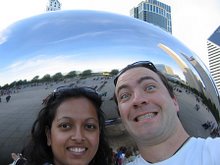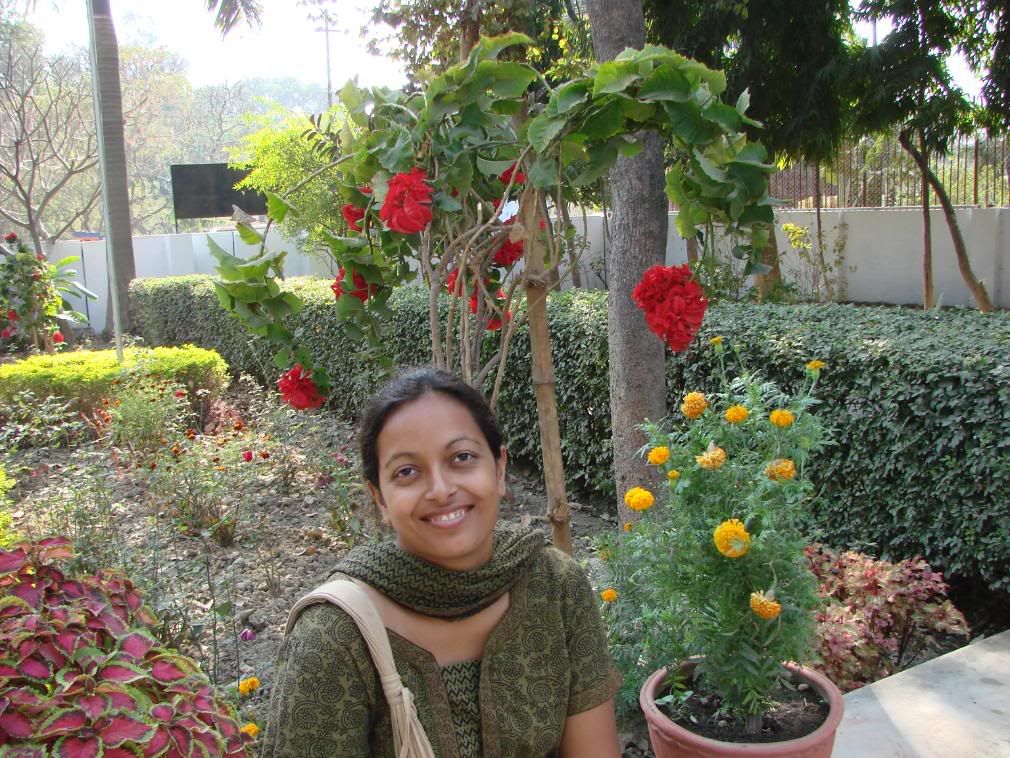 After meeting the family German Shepard named Kush, which means ‘happy’ in Hindi, the reunion was warm and relaxing. As is common among the middle class, they had live-in servants, and we were treated to our favorite Indian dishes. In addition, in India, the family is an extended one. So the three-bedroom condo consisted of Chuni Auntie, her husband and their married son and daughter-in-law. Their other daughter, who had a beautiful baby girl a week after we left (congrats!) lived with her husband three stories down in the same building. During these few weeks we met so many wonderful people and although we don’t remember everyone’s names, we will always remember how they went to every length to ensure that we were enjoying our visit. Thank you!
After meeting the family German Shepard named Kush, which means ‘happy’ in Hindi, the reunion was warm and relaxing. As is common among the middle class, they had live-in servants, and we were treated to our favorite Indian dishes. In addition, in India, the family is an extended one. So the three-bedroom condo consisted of Chuni Auntie, her husband and their married son and daughter-in-law. Their other daughter, who had a beautiful baby girl a week after we left (congrats!) lived with her husband three stories down in the same building. During these few weeks we met so many wonderful people and although we don’t remember everyone’s names, we will always remember how they went to every length to ensure that we were enjoying our visit. Thank you!We didn’t do any sightseeing in New Delhi and saved that for another trip to India. The following day began the journey with Priti’s Mom to Varanasi (or Benares, another Indian city with two names). This journey involved another overnight train on which we met a French woman who’d ridden Kingfisher (Jason’s camel on the Jaiselmer, Rajasthan safari) the day after our safari and we had a pleasant evening exchanging some of our travel stories.
We arrived in Benares and were greeted at the train station by friends who quickly became like family. Benares is the holiest city in India and Hindus pilgrimage there throughout the year and it is believed that all the Hindu Gods have set foot in Benares and bathed in the mighty Ganga (or Ganges) river, which is considered the source of life in Hinduism. We visited several temples which were jam-packed with worshippers. We then took a boat ride along the holy river and, as is customary, we sprinkled water from the river onto ourselves before eating. Many Hindus’ dying wish is to have their ashes sprinkled in the Ganga River. As we headed up the river, we passed along dozens of ghats, which are steps leading down to the river. It was fascinating yet disgusting to see the many uses people had of the river, including washing machine, toilet, and yes, even water fountain.
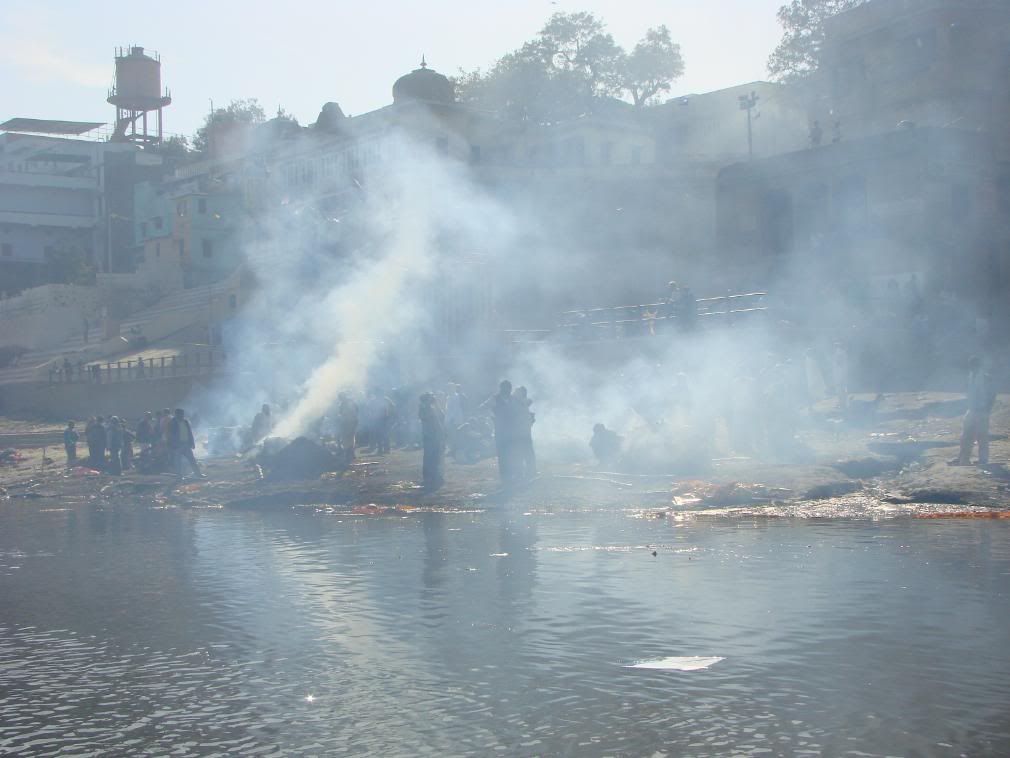 Several of the ghats are used for cremation ceremonies and we witnessed the cremation of several bodies from the boat. Although the air was smoky, it did not smell of burning flesh. We were fortunate to go on the boat ride because the following day, all the captains went on strike due to new higher boatmen’s license fees being imposed by the city government. On the way home, we stopped for some mythai and got the best carmel barfi we’ve ever had.
Several of the ghats are used for cremation ceremonies and we witnessed the cremation of several bodies from the boat. Although the air was smoky, it did not smell of burning flesh. We were fortunate to go on the boat ride because the following day, all the captains went on strike due to new higher boatmen’s license fees being imposed by the city government. On the way home, we stopped for some mythai and got the best carmel barfi we’ve ever had.Benares is a city of small streets that curve and angle every which way like a maze, and it is easy to get lost in the narrow alleys which is part of the fun. Down these alleyways, there are multitudes of street vendors selling just about anything and scooters weaving their way through the crowds of people and the revered cows.
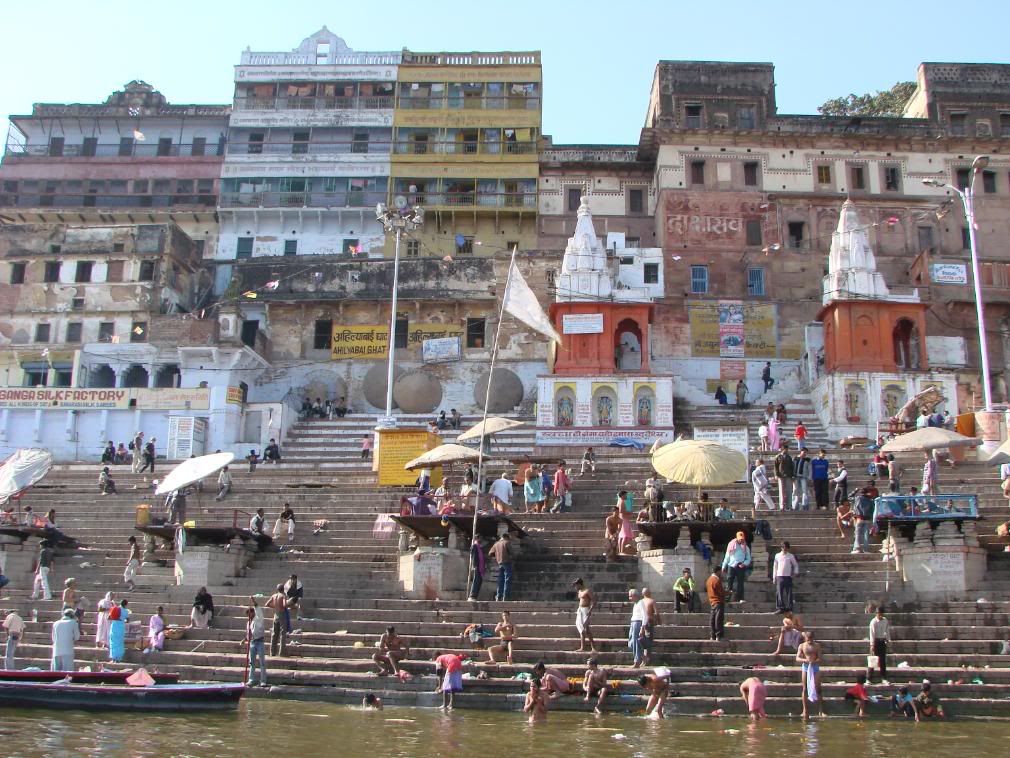 Cars are too wide to fit down the alleys. Priti and her mother had a harrowing experience with an angry bull that was bucking and running down a gulley. Priti ran into a strangers’ home and her mother ran into a nearby hotel for shelter. Although we both were frightened at the time, we laughed about it later. We’re pretty sure this cow was the same one that chased after our fellow globetrekkers Paul and Sapna just a few months earlier since it happened very close to the hotel at which they had stayed.
Cars are too wide to fit down the alleys. Priti and her mother had a harrowing experience with an angry bull that was bucking and running down a gulley. Priti ran into a strangers’ home and her mother ran into a nearby hotel for shelter. Although we both were frightened at the time, we laughed about it later. We’re pretty sure this cow was the same one that chased after our fellow globetrekkers Paul and Sapna just a few months earlier since it happened very close to the hotel at which they had stayed.Although we would recommend that everyone who visits India should go to Benares, please be forewarned that tourists get hounded by touts all the time. We were unfortunate to have one following us, trying to get us to book a room at a hotel. Despite the insistence of both Priti and her mother in Hindi, he continued to follow us and stated in Hindi, “Madam, you may be Indian but your husband is a foreigner. So I am working for him,” meaning that he could potentially make some money from Jason. After an hour of being followed, Priti was fed up, yelled at the guy and with the help of a local resident who stepped out of his home, the tout finally left us alone.
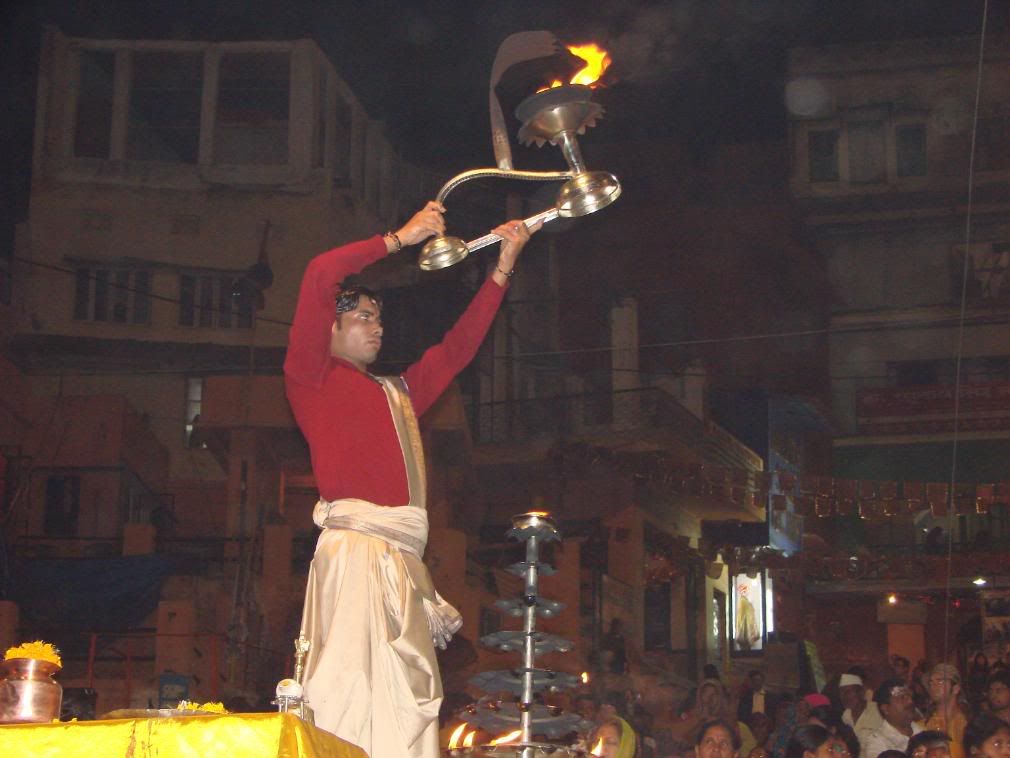 Later that evening, we saw the Ganga puja, a religious ceremony on the outdoor ghats during which six Hindu priests standing on platforms perform rituals of worship to honor the Ganga River that involve burning ghee (purified butter), incense, ringing bells, and chanting. Although at first the clanging sounded discordant, after awhile it became very hypnotic and peaceful. We began to understand how many of the other travelers we had met claimed to have found their spiritual awakening in India.
Later that evening, we saw the Ganga puja, a religious ceremony on the outdoor ghats during which six Hindu priests standing on platforms perform rituals of worship to honor the Ganga River that involve burning ghee (purified butter), incense, ringing bells, and chanting. Although at first the clanging sounded discordant, after awhile it became very hypnotic and peaceful. We began to understand how many of the other travelers we had met claimed to have found their spiritual awakening in India.The days spent in Benares were filled with exploration of the mazelike gulleys, eating delicious home-cooked Indian meals, stuffing our faces with Indian sweets, and listening to classical Indian music. Not only is Benares one of the holiest cities in India but it is also the sitar and tabla (Indian drums) capital. Jason took some tabla lessons but was barely able to get through the first lesson. However, he vowed to dust off the tablas when we returned to Tucson. (Gee-gee-tee-tee-gee-gee-na-na Kee-kee-tee-tee-gee-gee-na-na).
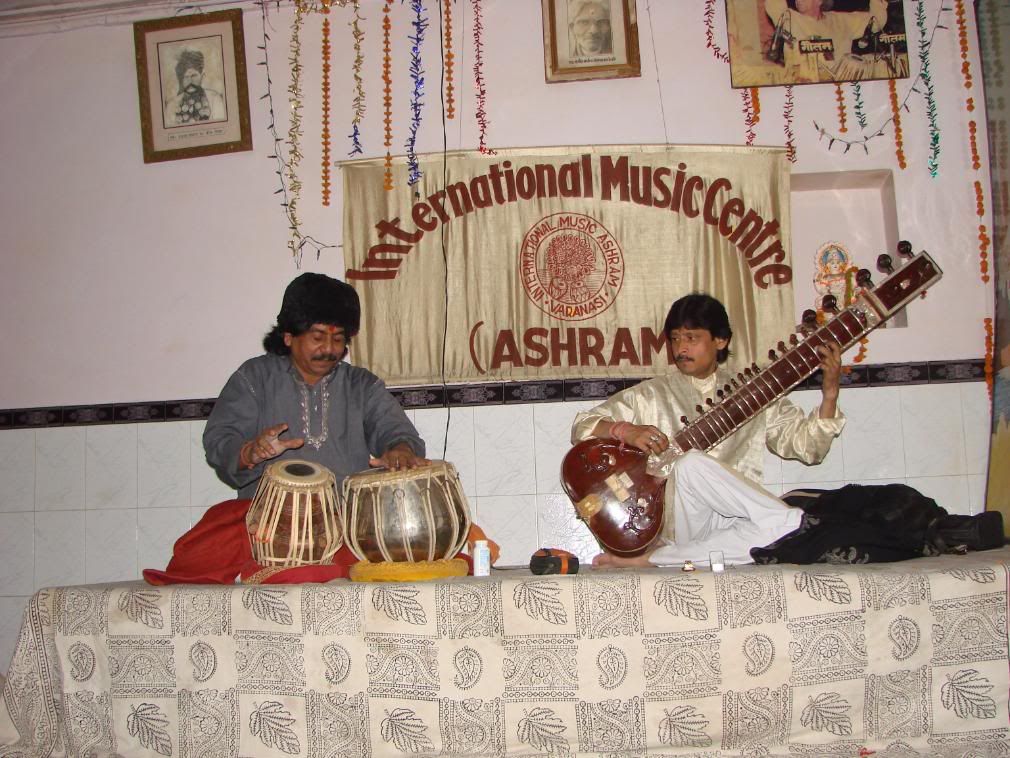 On a couple evenings, we attended classical Indian music concerts. Jason went out by himself one evening and, upon returning around midnight, found the entrance gate was locked. The night guard did not speak English but after some hand gestures Jason realized he wanted some money to let him in. After being let in, Jason handed him a 50-rupee note and planned to report him to our host. To our utter amazement, the guard showed up the following morning expecting us to give him more gifts for his generosity the previous evening!
On a couple evenings, we attended classical Indian music concerts. Jason went out by himself one evening and, upon returning around midnight, found the entrance gate was locked. The night guard did not speak English but after some hand gestures Jason realized he wanted some money to let him in. After being let in, Jason handed him a 50-rupee note and planned to report him to our host. To our utter amazement, the guard showed up the following morning expecting us to give him more gifts for his generosity the previous evening!About ten kilometers north of Benares, the ancient town of Sarnath is one of the four main Buddhist pilgrimage sites because it is the place where Buddha taught his disciples. We hired an auto to take us to the main sites, including the place where Buddha allegedly gave his first lecture.
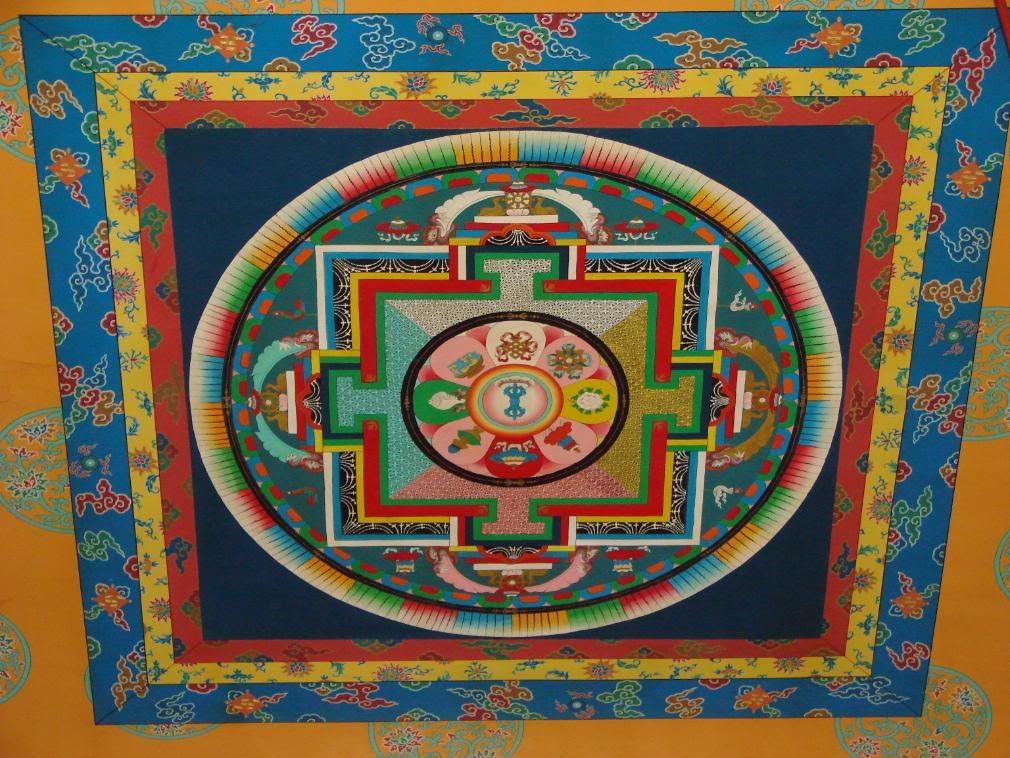 We also visited the five main Buddhist temples which are replicated in the architectural styles of five countries with large proportions of Buddhists: Japan, China, Tibet, Burma, and Thailand (which is still under construction). The Nepalese Buddhist temple had awesome mandala paintings on the ceilings while the Japanese temple had wooden sculptures and serene gardens. The Burmese temple was probably the most interesting since it is highly unlikely that the political situation will become amenable to tourists during our lifetimes.
We also visited the five main Buddhist temples which are replicated in the architectural styles of five countries with large proportions of Buddhists: Japan, China, Tibet, Burma, and Thailand (which is still under construction). The Nepalese Buddhist temple had awesome mandala paintings on the ceilings while the Japanese temple had wooden sculptures and serene gardens. The Burmese temple was probably the most interesting since it is highly unlikely that the political situation will become amenable to tourists during our lifetimes.On our last day in Benares, we went to the Benares University Museum which houses ancient statues of Hindu gods and goddesses, a collection of miniature paintings, and paintings from a German artist who fell in love with Benares in the 1950s. After exploring this museum, which is excellent, we went on a shopping spree. During our travels we have been pretty disciplined about not shopping, mostly because we have no space in our backpacks. However, upon Priti’s request, her mother had brought an empty suitcase to India which we filled with souvenirs and other items of interest. Both Priti’s mom and Priti splurged and bought custom designed silk bed sets.
Our next adventure started the following day as we waited at the Benares train station for two hours for the train to Putna, where Priti and her mother have family. To be perfectly honest, there is no other reason to visit Putna. Anyways, the train ride which was scheduled to be five hours took seven plus. Perhaps this explains it....('moooooove', we shouted, but to no avail).
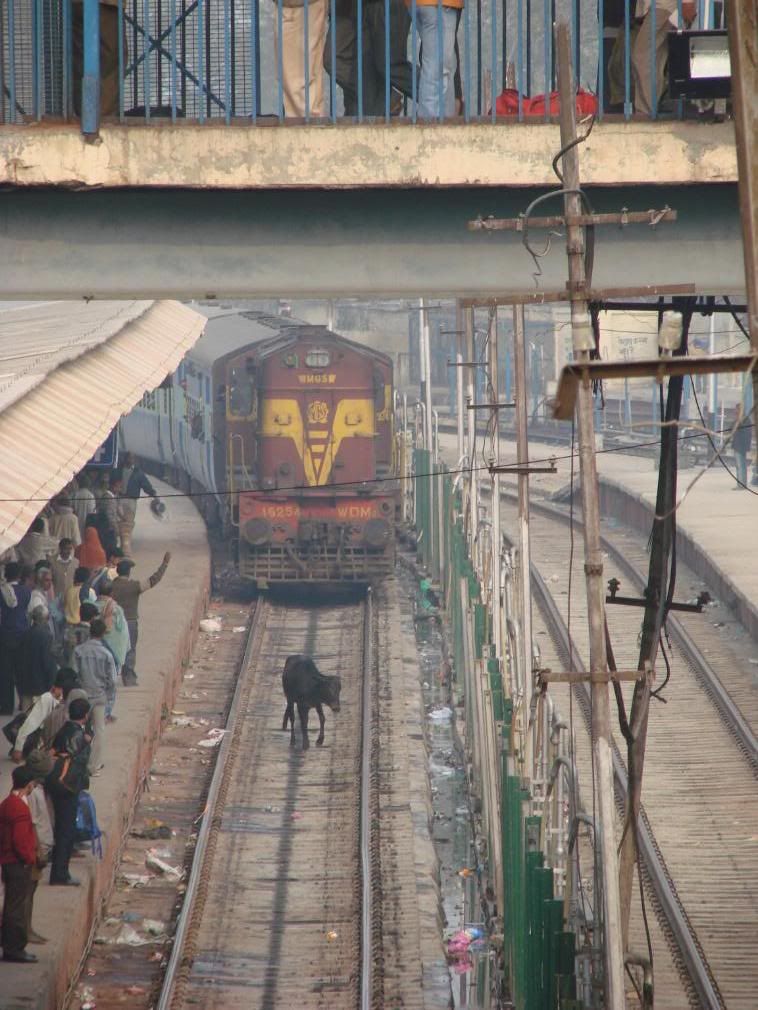 At half past midnight we arrived at the Putna train station, greeted by a couple of Priti’s father’s cousins who then showed us tremendous hospitality at their home. Dinner was prepared and served at one am in the morning! This Uncle and Auntie were renting a flat while their home was being constructed and apologized repeatedly for the cramped quarters. Despite their hospitality, the next day while Priti’s mother stayed with family, Priti and Jason checked into a hotel. It had nothing to do with the cramped quarters but the nausea inducing squatter toilet was too much to handle.
At half past midnight we arrived at the Putna train station, greeted by a couple of Priti’s father’s cousins who then showed us tremendous hospitality at their home. Dinner was prepared and served at one am in the morning! This Uncle and Auntie were renting a flat while their home was being constructed and apologized repeatedly for the cramped quarters. Despite their hospitality, the next day while Priti’s mother stayed with family, Priti and Jason checked into a hotel. It had nothing to do with the cramped quarters but the nausea inducing squatter toilet was too much to handle.In Putna, we met many relatives – uncles, aunts, cousins and more cousins. On the way to Divakar and Dilip Uncles’ home, the auto-walla (three wheeled open taxi person) got lost. A man dressed in beige on a motorcycle stopped us and asked if we needed help. He then proceeded to escort us to our Uncle’s residence.
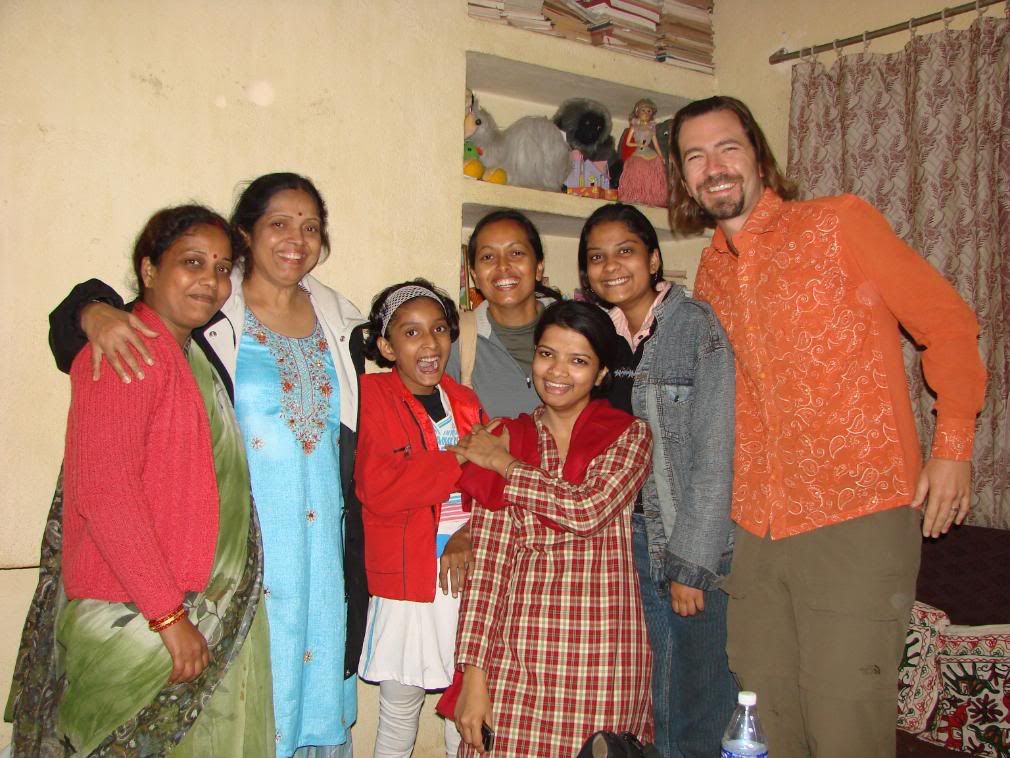 Later we learned that this kind man was a police officer and he was concerned, that with a foreigner (Jason) in the auto, that we might be taken advantage of. The hospitality of our family was unbelievable. We were offered and served cups of chai (Indian tea), sweets, and delicious food and great conversation. Priti’s autistic cousin rubbed her arm and repetitively and affectionately called her ‘Thithee’ (respectfully older sister). Jason tried in vain to learn the rules of cricket while playing with some cousins. Priti’s cousins, all of whom were teenagers or young adults, were educated in English and conversed with Jason without the requirement of a translator.
Later we learned that this kind man was a police officer and he was concerned, that with a foreigner (Jason) in the auto, that we might be taken advantage of. The hospitality of our family was unbelievable. We were offered and served cups of chai (Indian tea), sweets, and delicious food and great conversation. Priti’s autistic cousin rubbed her arm and repetitively and affectionately called her ‘Thithee’ (respectfully older sister). Jason tried in vain to learn the rules of cricket while playing with some cousins. Priti’s cousins, all of whom were teenagers or young adults, were educated in English and conversed with Jason without the requirement of a translator.Conversing with Ankita, one of Priti’s cousins was interesting because she finished taking high school exams and described studying for them like a college student who pulls all-nighters. In India, there is a lot of pressure and academic competition. Only 16 years old, Ankita wants to be an Engineer - most likely. She’s a teenager who speaks about Hindi film stars but also talks about her future career as though she is an adult. From her and other female cousins, we learned more about how the Dowry system continues to be ingrained in the Bihari Indian culture.
Putna is in the state of Bihar, which is the most “backwards” and least educated state in all of India. It also has a reputation of being one of the most corrupt states too. Dowry, although illegal, is a sexist practice of the bride’s family giving money and “gifts” to the groom’s family in order to have their daughter married. Often, the dowry can be the family’s life savings and can result in poverty. One cousin of marriageable age had a potential match but the groom’s family was asking for a Maruti car in addition to lots of money and gifts of gold jewelry and silk saris. This cousin has a college education and earns good money. Unfortunately, in Bihar and other parts of India, women are often viewed as a financial burden. For example, many families cry after the birth of a baby girl but celebrate after the birth of a baby boy. Needless to say, in our opinion the dowry system is horrible. Neither of us understand how Hindus worship Goddesses yet the Indian culture treats women like they are second class citizens. This has created a country where, unlike the majority of the world, the population of men exceeds that of women. Furthermore, although India is beautiful, exotic, and hospitable in many ways, it also has a history of female infanticide, bride burning and sati (when a widower throws or is thrown onto her husband’s burning pyre).
The following day, Jason and Priti explored Putna on their own. There wasn’t much. At a nearby park, we briefly watched a cricket match. For those of you, like us, who have never understood or cared about cricket, it is the national sport of India. In most countries, when we pass by fields the children play football (soccer) but in India, all the kids play cricket. There was a huge scandal while we were there because an umpire made a controversial call that allowed the Aussie team to extend their batting and nearly cost India the match. After watching the game, we went to the Mahatma Ghandhi Museum which was small but interesting. Below is a great quote from a great man.
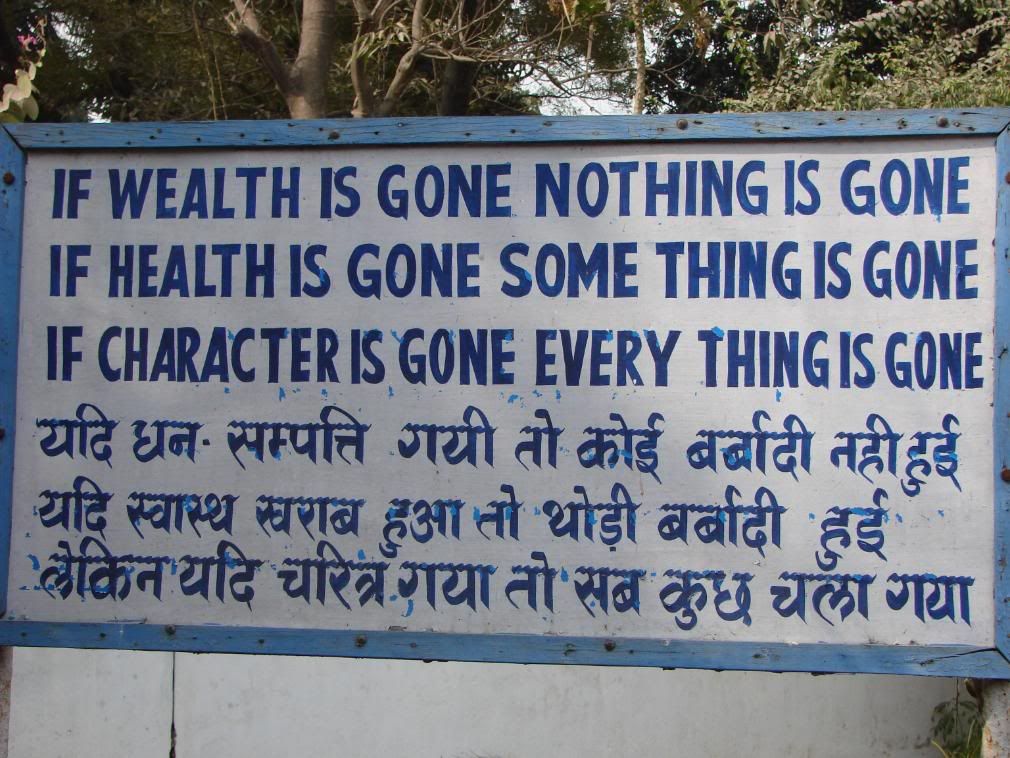 The bookshop had many great books and Ghandhi had ensured that his books would not be sold for a profit. Priti bought his autobiography for less than one US dollar while Jason picked up The Essence of Hinduism. We both recently read his autobiography and though he was no doubt an incredible person and led India's independence movement, he was also very eccentric and espoused some practices which neither of us found remotely palatable (e.g., bramacharya). That evening, we celebrated Priti’s birthday at the Bellpepper Restaurant where the tandoori chicken in an Afghani curry sauce was divine.
The bookshop had many great books and Ghandhi had ensured that his books would not be sold for a profit. Priti bought his autobiography for less than one US dollar while Jason picked up The Essence of Hinduism. We both recently read his autobiography and though he was no doubt an incredible person and led India's independence movement, he was also very eccentric and espoused some practices which neither of us found remotely palatable (e.g., bramacharya). That evening, we celebrated Priti’s birthday at the Bellpepper Restaurant where the tandoori chicken in an Afghani curry sauce was divine.The following day, our last in Putna, the rain was coming down in torrents. After gorging at the same restaurant for lunch with Lata, we walked along the puddle filled streets for nearly an hour looking for an auto-walla. The three of us finally squeezed into the open three-wheeled auto and held down the plastic “window curtains” in a hopeless attempt to not get even more drenched than we already were. Having recently gotten over a two-month bout of bronchitis, Jason was particularly worried. Forty-five minutes later, we arrived at our Uncle’s home where we were greeted warmly with blankets and they started a fire in a large, movable metal container with hot coals and wood. In India, no one has heaters or central heating. Although we appreciated their concern, the smoke quickly filled the house and became suffocating. After spending another day and night conversing and indulging in good Indian food with extended family, we said our goodbyes and got into an auto to the train station. The auto broke down three times along on the way within the first five minutes and we were nervous about missing the overnight train to Priti’s mother’s town/village of Purnia. Thankfully, it was only drizzling and we ditched the first auto-Walla and caught a large share-auto that was heading to the train station. About 20 minutes later, we reached the Putna Train Station but had to walk about 100 meters in the light rain and avoid massive puddles in the dimly lit road. Finally we boarded the train, relieved that we had 15 minutes to spare until departure time and we laughed at how we could have easily missed the train.
There was a Swiss traveler in our compartment who told us about a recent harrowing experience. A Nepalese man befriended him in Jaipur, and then followed him to A gra but acted like it was a coincidence. This man then showed him around town and treated him to meals and entertainment. They had dinner in his hotel room and after it was served the Nepalese man started stirring around the Swiss man’s food. He quickly began to feel ill and thus didn’t finish his meal. For the rest of the evening, he alternated between passing out and retching. The Nepalese “friend” returned to the hotel room to make sure his Swiss friend was alright and then left. The next morning the Swiss man awoke to realize that he had been robbed of about $1000 dollars and his train ticket to Calcutta was gone. Initially, he believed that it was the hotel restaurants’ staff that had put something in his food. When he went to the restaurant, however, he learned that the staff who had eaten his leftover lamb curry had gotten sick too. Later, the Swiss traveler put it together that he had been drugged and robbed by his “friend.” Lata was amusingly frank with this guy and told him “I’m sorry to talk like this but you’re not very smart.” A few words of advice on traveling: NEVER TRUST ANYONE (sad but true).
At 5:30 am, we arrived at the Katihar Train Station and were greeted by Priti’s cousin. We all got into the Tata SUV and drove in the pre-dawn darkness to Priti’s maternal Uncles’ (Mama in Hindi) homes. The shops were closed and the people, mostly farmers, were starting to wake up and stretch outside their huts. Some kids were also awake at this ungod
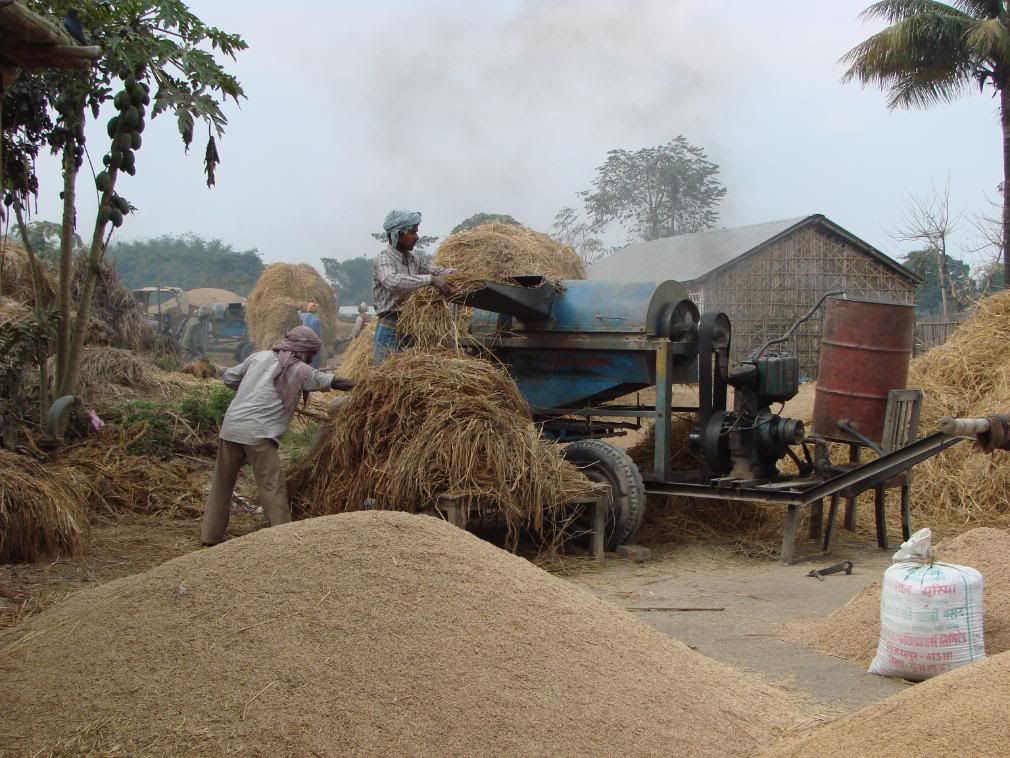 ly hour getting ready for their farming chores. The huts were made of criss-crossed thatched plant material mixed with mud and the roofs were thatched dried long leaves of a native plant. Cows were attached to posts and stood in the small yards of the villagers. Priti’s two Mamas (maternal uncles) and their families live in homes attached to each other with a shared front yard like a traditional extended family in India. We were exhausted from so many overnight train rides within the last week so we slept while Lata excitedly caught up with her two brothers’ families. The last time she had seen her family was eight months ago when she attended her nephew’s wedding. She was pleased to learn that the newlyweds were expecting a baby.
ly hour getting ready for their farming chores. The huts were made of criss-crossed thatched plant material mixed with mud and the roofs were thatched dried long leaves of a native plant. Cows were attached to posts and stood in the small yards of the villagers. Priti’s two Mamas (maternal uncles) and their families live in homes attached to each other with a shared front yard like a traditional extended family in India. We were exhausted from so many overnight train rides within the last week so we slept while Lata excitedly caught up with her two brothers’ families. The last time she had seen her family was eight months ago when she attended her nephew’s wedding. She was pleased to learn that the newlyweds were expecting a baby.Purnia was “real India” in the sense that it was completely off of the beaten track. Jason was the only white person in town and most likely the entire provincial area. Family members recalled a “white person” being in their nearby village maybe 40-50 years ago! Priti and her Mom were surprised and disheartened to learn that the bride of eight months was practicing purdah at the demand of her husband (Priti’s cousin). Purdah is when the woman of the household, usually recently married, doesn’t show her face to strangers.
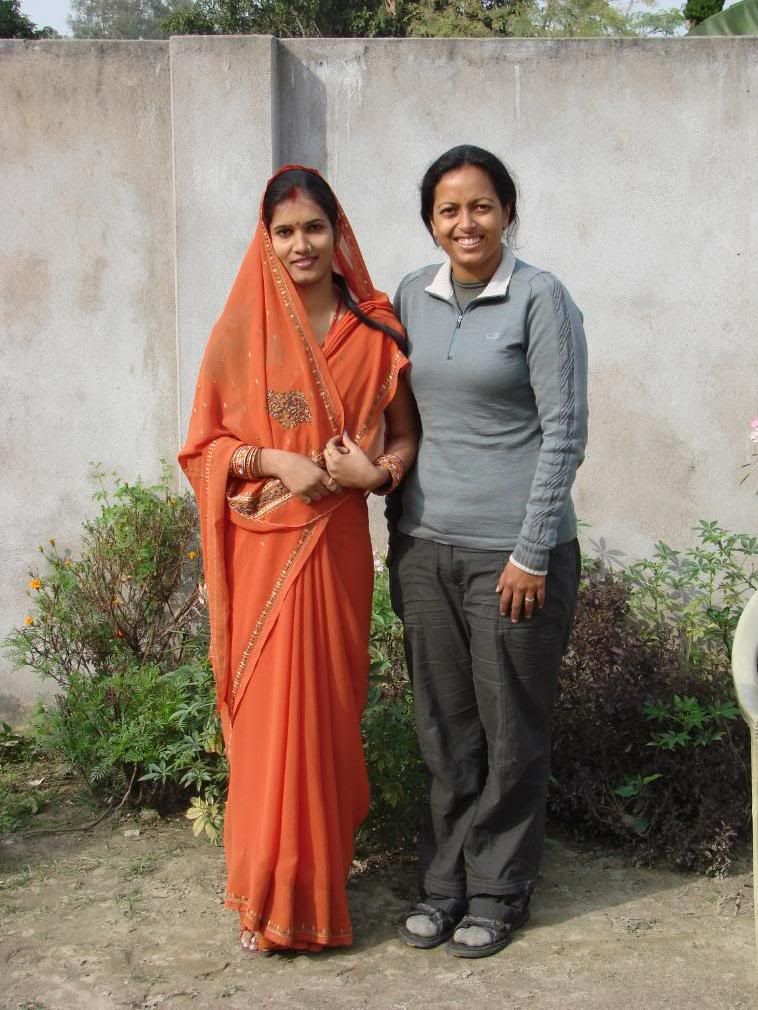 This requires her to stay within the family compound and to not venture outside of the home. It is most often practiced in rural areas. Although Lata observed Purdah, that was forty years ago and she no longer approves of this outdated and oppressive practice. As mentioned previously, Bihar is in a time warp in terms of women’s rights. This new bride did almost all the chores and cooking with some help from her mother-in-law. Although she described being content to practice purdah, it was apparent that she missed going outside and would stand at the doorway when Priti and her teenage cousin Puja played badminton in the front courtyard. Priti suggested that they switch clothes and exchange positions, to which her cousin laughed and said that it was impossible. However, on our final day, at Lata's behest (and since she is the oldest she gets to call the shots), the outdated practice of Purdah was momentarily suspended as the entire family went outside to take pictures (see above picture).
This requires her to stay within the family compound and to not venture outside of the home. It is most often practiced in rural areas. Although Lata observed Purdah, that was forty years ago and she no longer approves of this outdated and oppressive practice. As mentioned previously, Bihar is in a time warp in terms of women’s rights. This new bride did almost all the chores and cooking with some help from her mother-in-law. Although she described being content to practice purdah, it was apparent that she missed going outside and would stand at the doorway when Priti and her teenage cousin Puja played badminton in the front courtyard. Priti suggested that they switch clothes and exchange positions, to which her cousin laughed and said that it was impossible. However, on our final day, at Lata's behest (and since she is the oldest she gets to call the shots), the outdated practice of Purdah was momentarily suspended as the entire family went outside to take pictures (see above picture).During those several days, Jason followed in Gandhi's footsteps and fasted in order to avoid the squatting toilet (to no avail). There was also no hot shower, though there was a bathroom with a shower area and faucets but no Western shower head. Bathing required heating a large bucket of water, mixing it with cold water until it was bearable to touch, and then using a large ladle to pour water over yourself and alternate with using soap. This is called an Indian “bucket shower.” It is usually the norm in any Indian household even if the family has wealth. Hotels, however, often have the American standard shower with low water pressure and one always has to ask if they have hot water from the shower. If not, then it’s another bucket shower.
The days in Purnia were lazy ones. We played Karem board, talked, watched TV, ate, and slept. It was fun for Priti to listen to her family members tell her stories about themselves and of her mother. Meanwhile, Jason and Priti’s youngest cousin Prince played old school Nintendo games like Super Mario Bros. and Contra, although for the life of him Jason couldn’t recall the code that would have given us 99 lives (up-down-up-down-left-right-left-right-a-b-a-b-start?). Granted, doing anything that required electricity was hit or miss. Often, in the middle of a Bollywood movie, there would be a brownout. Usually, the power would come back within a few hours.
One day, we all drove 45 minutes east of Purnia to visit Priti’s grandparents in their village. Although the house they have lived in most of their lives is dilapidated, they refuse to move in with their sons. Priti’s Nana (grandfather) is a farmer, still has his wits about him, and continues to oversee his 100 acres of farmland.
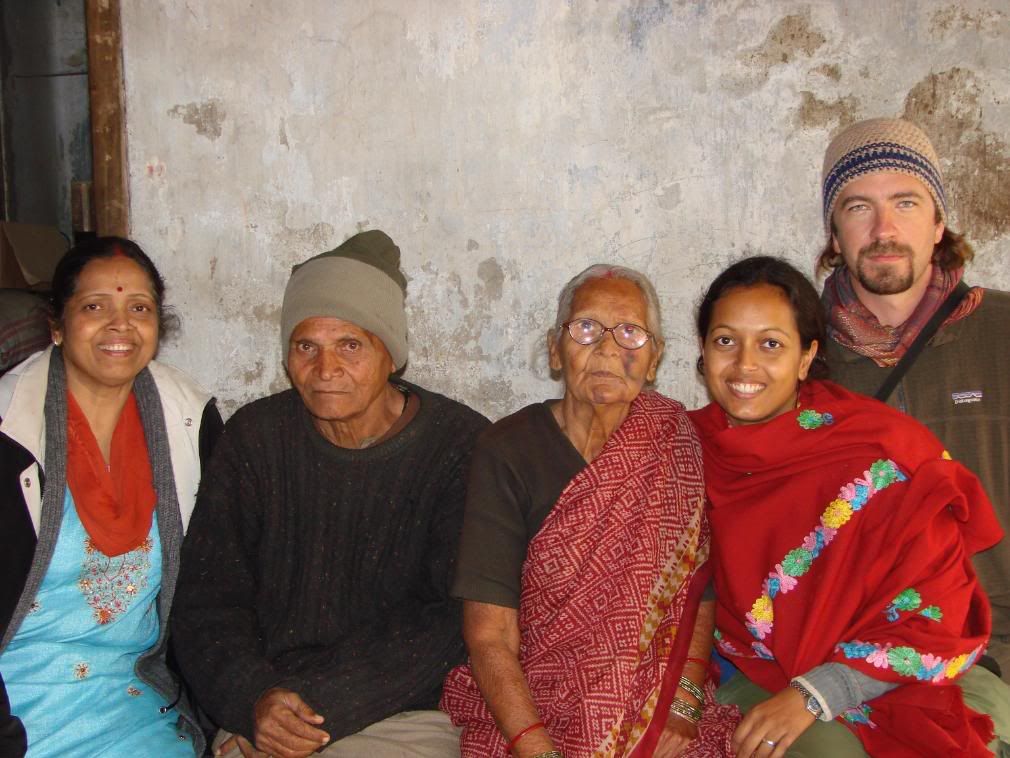 Some of the organic crops he grows include mangoes, sugarcane, bananas, wheat, rice, potatoes and other vegetables. Nanee, (grandmother) unfortunately, has dementia so when she visits her sons’ homes becomes more confused so we somewhat understood why they wanted to remain in familiar surroundings . Luckily, they have servants to help them with basic daily needs. We all were very excited to see Priti’s grandparents who were thrilled to finally meet Jason. Nana tried talking to Jason in his Bajpuri dialect and soon learned that Jason did not understand a single word and Priti only understood half of what he was saying. (The dialect is different from the language of Hindi but has some words in common.) Priti’s mom was excited to see how the crops were doing and she even picked some potatoes in the fields.
Some of the organic crops he grows include mangoes, sugarcane, bananas, wheat, rice, potatoes and other vegetables. Nanee, (grandmother) unfortunately, has dementia so when she visits her sons’ homes becomes more confused so we somewhat understood why they wanted to remain in familiar surroundings . Luckily, they have servants to help them with basic daily needs. We all were very excited to see Priti’s grandparents who were thrilled to finally meet Jason. Nana tried talking to Jason in his Bajpuri dialect and soon learned that Jason did not understand a single word and Priti only understood half of what he was saying. (The dialect is different from the language of Hindi but has some words in common.) Priti’s mom was excited to see how the crops were doing and she even picked some potatoes in the fields. 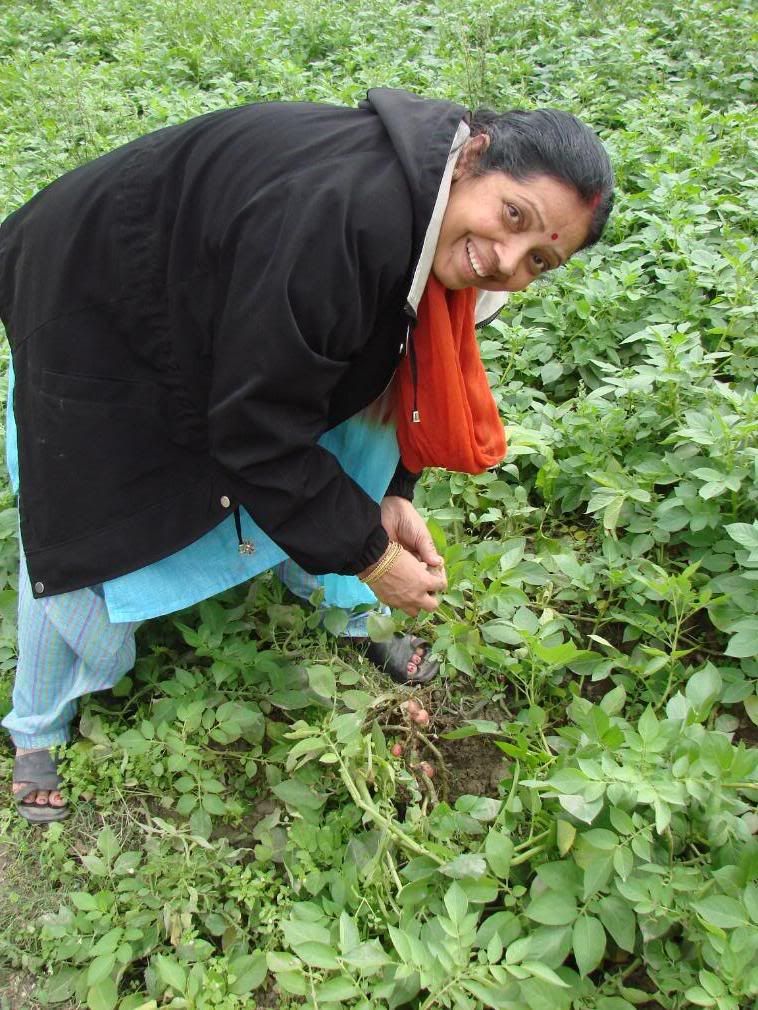 Those curried potatoes were delicious that night too! Too bad it wasn’t mango season since that is both of our favorite fruit. We also watched as workers placed the cut rice stalks from a large mound through a machine that separates the rice grains to be stored and sold by the family. While we were there, some thieves stole about 80 kilos of potatoes during the night.
Those curried potatoes were delicious that night too! Too bad it wasn’t mango season since that is both of our favorite fruit. We also watched as workers placed the cut rice stalks from a large mound through a machine that separates the rice grains to be stored and sold by the family. While we were there, some thieves stole about 80 kilos of potatoes during the night.On the last day in Purnia, the atmosphere was sad as we said goodbye to our family and left for the train station to take yet another long overnight journey to New Delhi. This time, however, we are on one of the best trains in India called the Rajdhani Express which provides bedding for the berths, food service and Western facilities. And for once, all three of us were in the same compartment. We were served a pretty good vegetarian dinner and tea for dinner. In addition, Jason was relieved to find that the Rajdhani Express had a western toilet and ample t.p. After the 20 hour train ride, we reached the New Delhi Train Station. We said a brief good-bye to Lata since she opted to stay with family in New Delhi versus going to see the Taj Mahal, and then got on another train to Agra. No trip to northern India is complete without seeing the Taj Mahal in Agra. After our arrival there, we quickly found a hotel and watched the sunset from the rooftop which provided a pretty good view of the Taj. Unfortunately, Agra was cold and since the hotel didn’t have heat, we were very cold and uncomfortable that night despite the blankets covering us.
The following day, we planned to go to the Taj Mahal separately and then meet inside of the compound. Taj Mahal is surrounded by a fortified wall which has two entrance points. In India, foreigners have to pay 850 rupees ($21) to enter the Taj whereas Indians only pay 20 rupees.
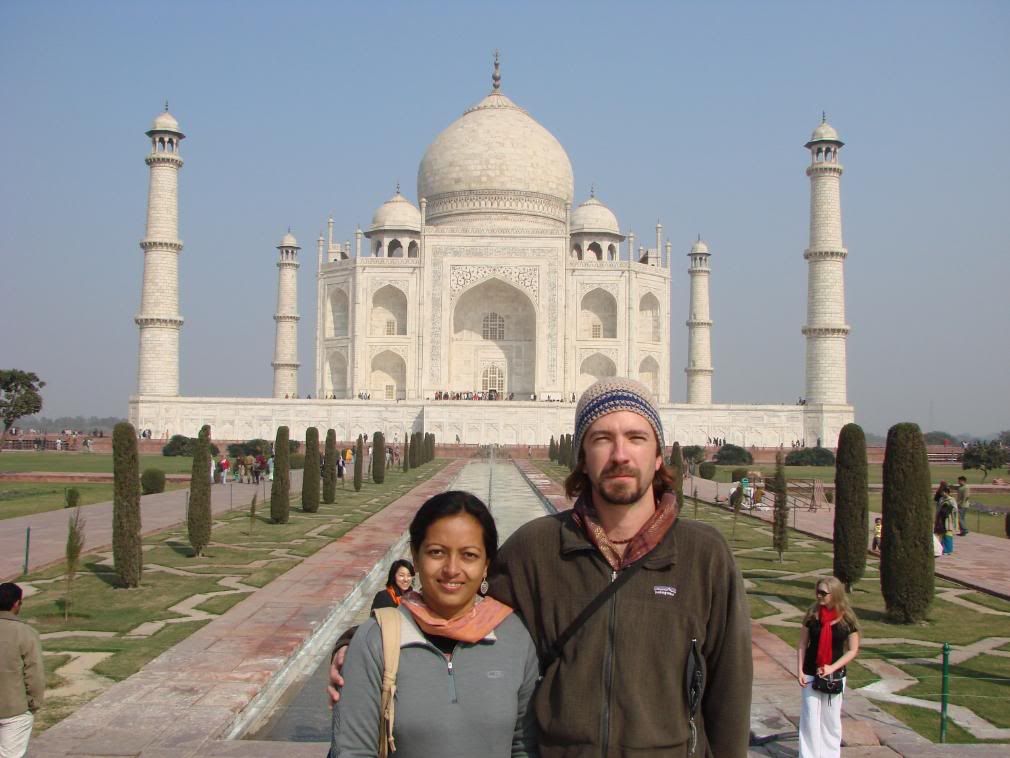 Based on Sapna’s suggestion, Priti decided that since she was born in India, she was Indian and should therefore get the locals discount. She dressed up in her Indian clothes and wrapped a shawl around her shoulders. She looked so Indian that a foreigner took a picture of her in front of the Taj Mahal. Yet, she got questioned not only by the ticket vendor, but the ticket taker, and the security person about where she was born (Baroda, India), where her family was from (Purnia, Bihar), where she lived in India (Ghaziabhad with her relatives near New Delhi which was partly true), and even what was her address in India which spilled off of her tongue easily since she had memorized her cousin’s address. So Priti somehow managed to pay 20 rupees to see the Taj Mahal. Shockingly, Jason managed to get in for free. He had to deposit his electronic goods at security with the exception of the camera and then walked past security.
Based on Sapna’s suggestion, Priti decided that since she was born in India, she was Indian and should therefore get the locals discount. She dressed up in her Indian clothes and wrapped a shawl around her shoulders. She looked so Indian that a foreigner took a picture of her in front of the Taj Mahal. Yet, she got questioned not only by the ticket vendor, but the ticket taker, and the security person about where she was born (Baroda, India), where her family was from (Purnia, Bihar), where she lived in India (Ghaziabhad with her relatives near New Delhi which was partly true), and even what was her address in India which spilled off of her tongue easily since she had memorized her cousin’s address. So Priti somehow managed to pay 20 rupees to see the Taj Mahal. Shockingly, Jason managed to get in for free. He had to deposit his electronic goods at security with the exception of the camera and then walked past security. 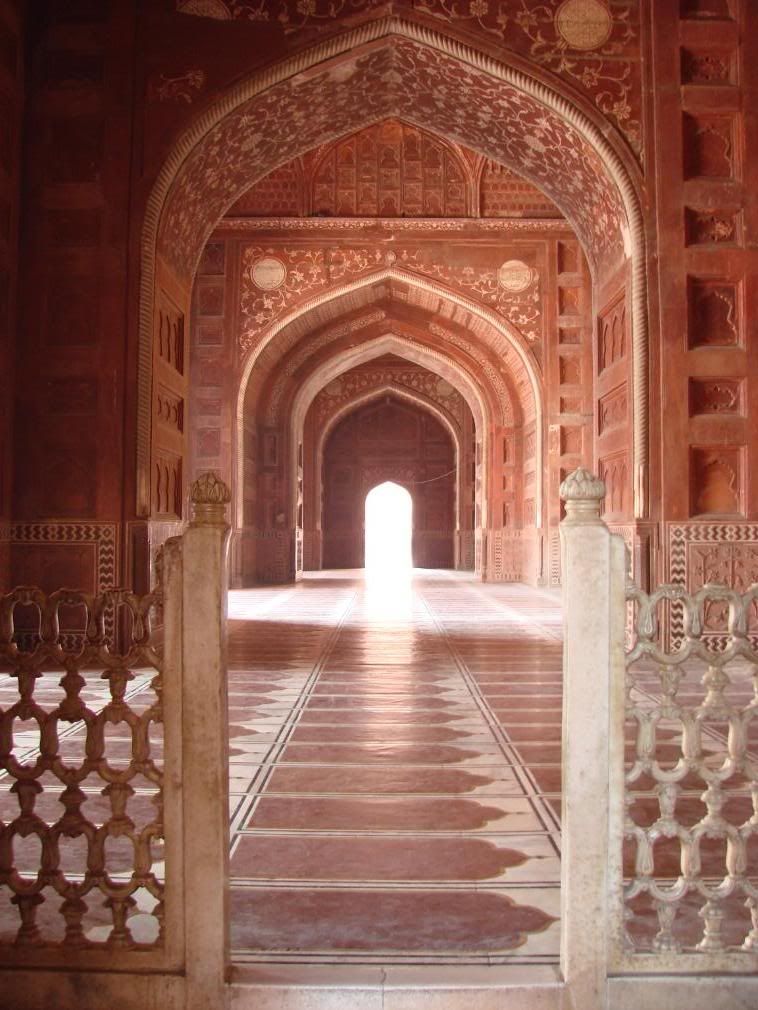 No one stopped him and Jason didn’t even know that he had gone through the entrance until he met Priti in the courtyard at which point she described her interrogation, and he replied with, “The entrance was out there? I thought it was actually to go into the Taj Mahal.” Somehow Jason, “the Foreigner” managed to get into Taj Mahal compound for free and Priti, “the Indian” paid 20 rupees, a mere fifty cents! Haha, suckers!
No one stopped him and Jason didn’t even know that he had gone through the entrance until he met Priti in the courtyard at which point she described her interrogation, and he replied with, “The entrance was out there? I thought it was actually to go into the Taj Mahal.” Somehow Jason, “the Foreigner” managed to get into Taj Mahal compound for free and Priti, “the Indian” paid 20 rupees, a mere fifty cents! Haha, suckers!Anyways, the Taj Mahal is grand and awe inspiring, even for Priti who was seeing it for the third time. The gardens are immaculate and the cleanest grounds that both Priti and Jason have seen in all of India.
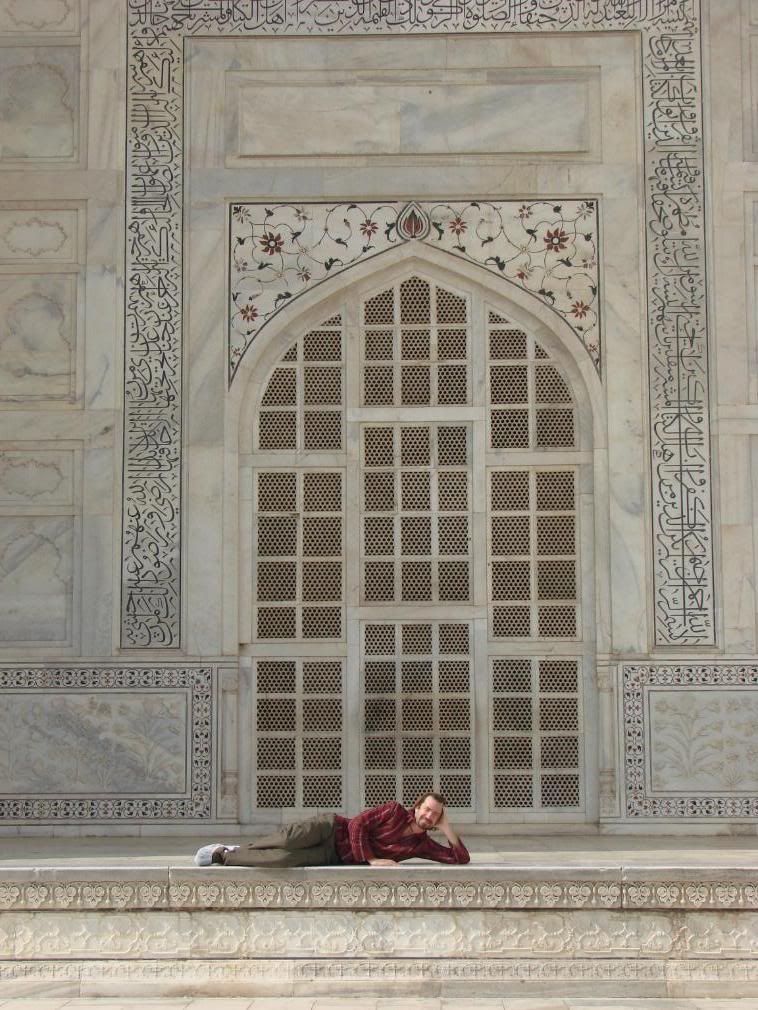 It was the last sight seen in India before we headed back to New Delhi to see Priti’s mom and family. Then, the following day, we continued on our travels by flight to Cairo, Egypt.
It was the last sight seen in India before we headed back to New Delhi to see Priti’s mom and family. Then, the following day, we continued on our travels by flight to Cairo, Egypt.
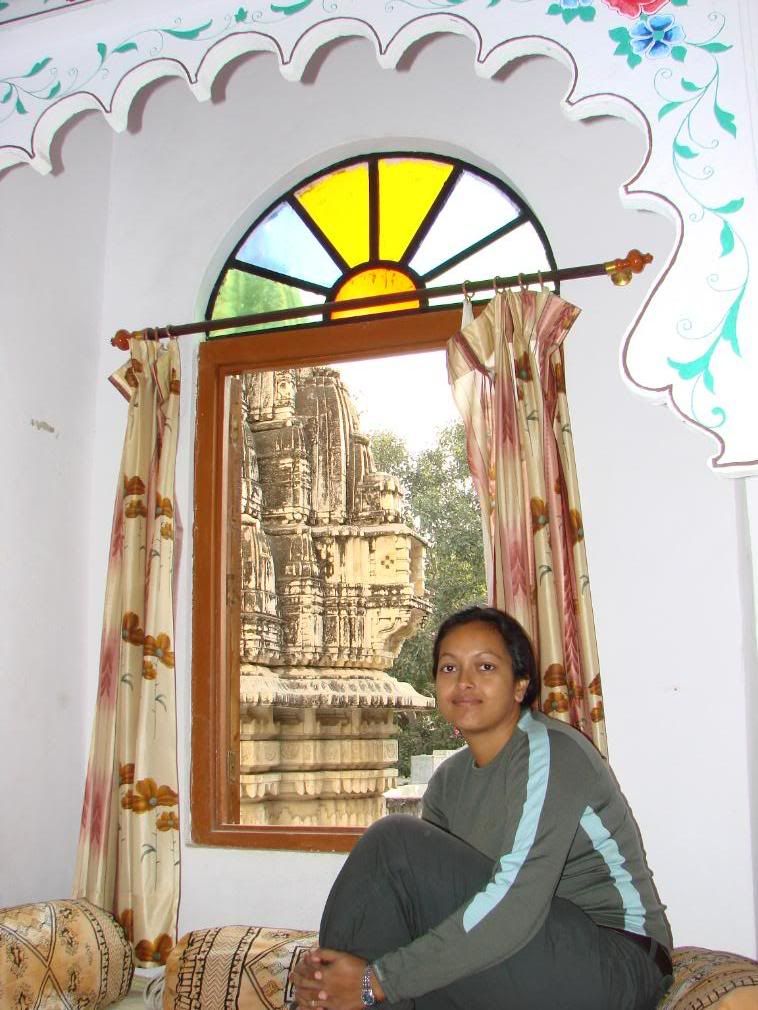
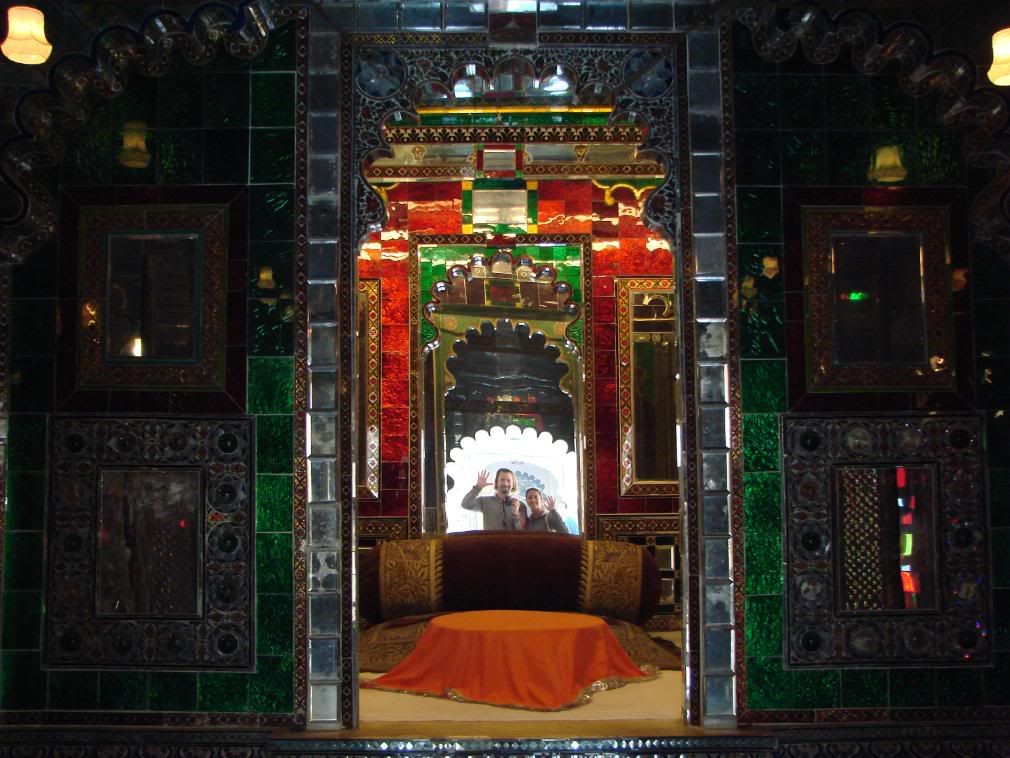
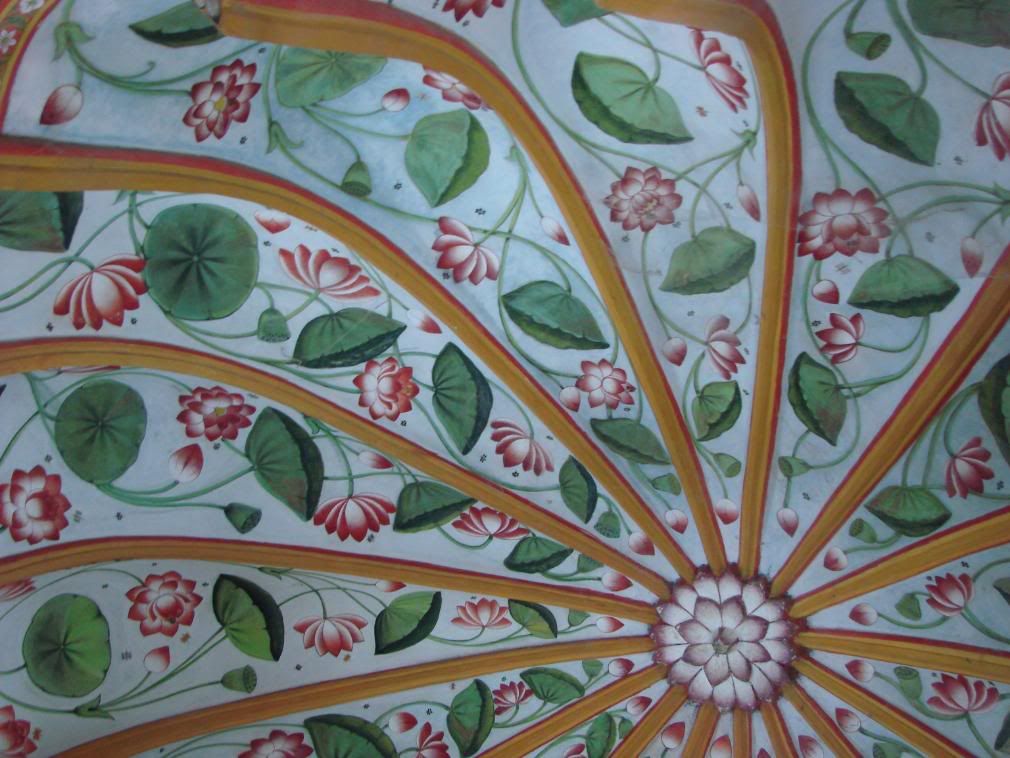

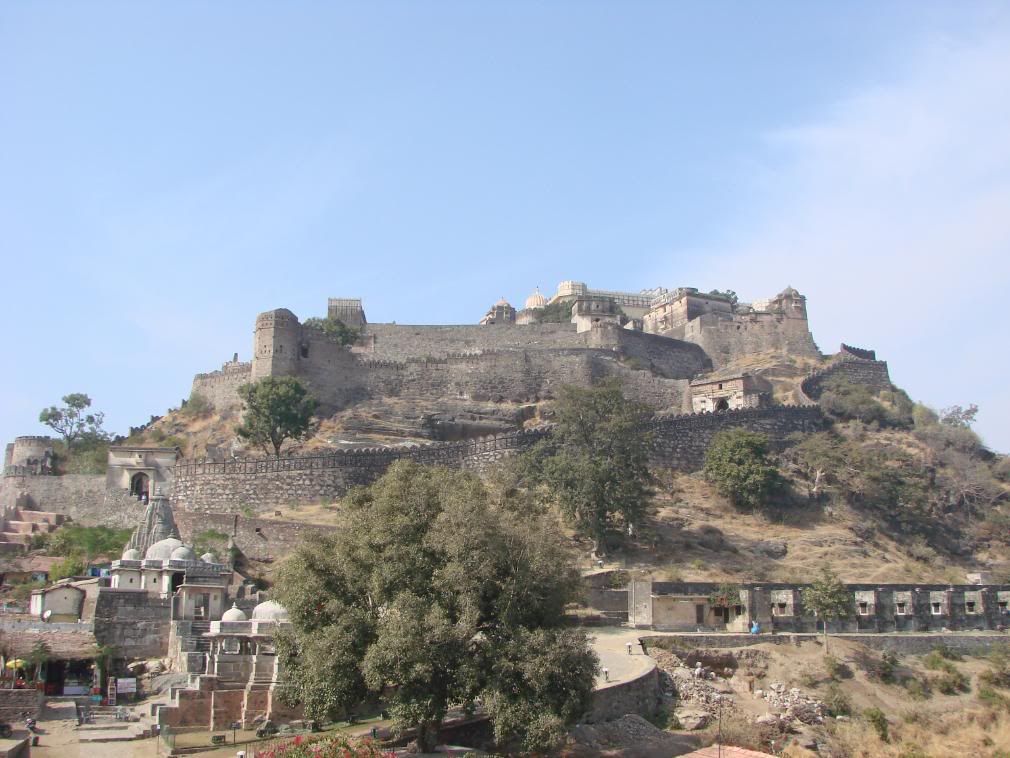
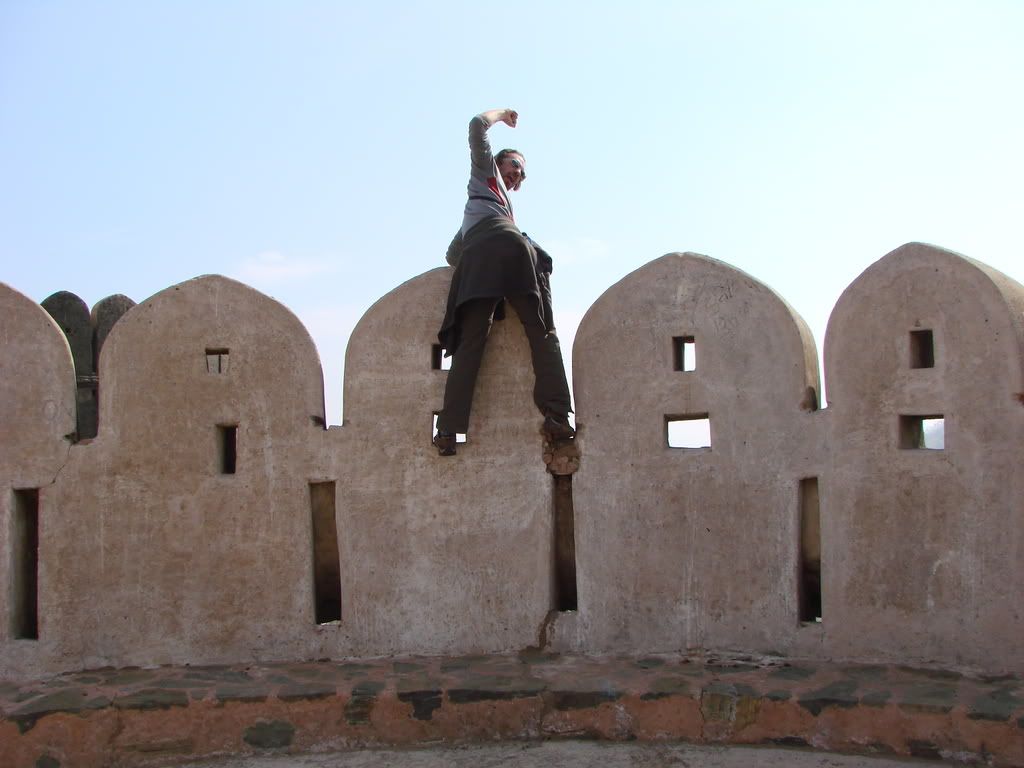
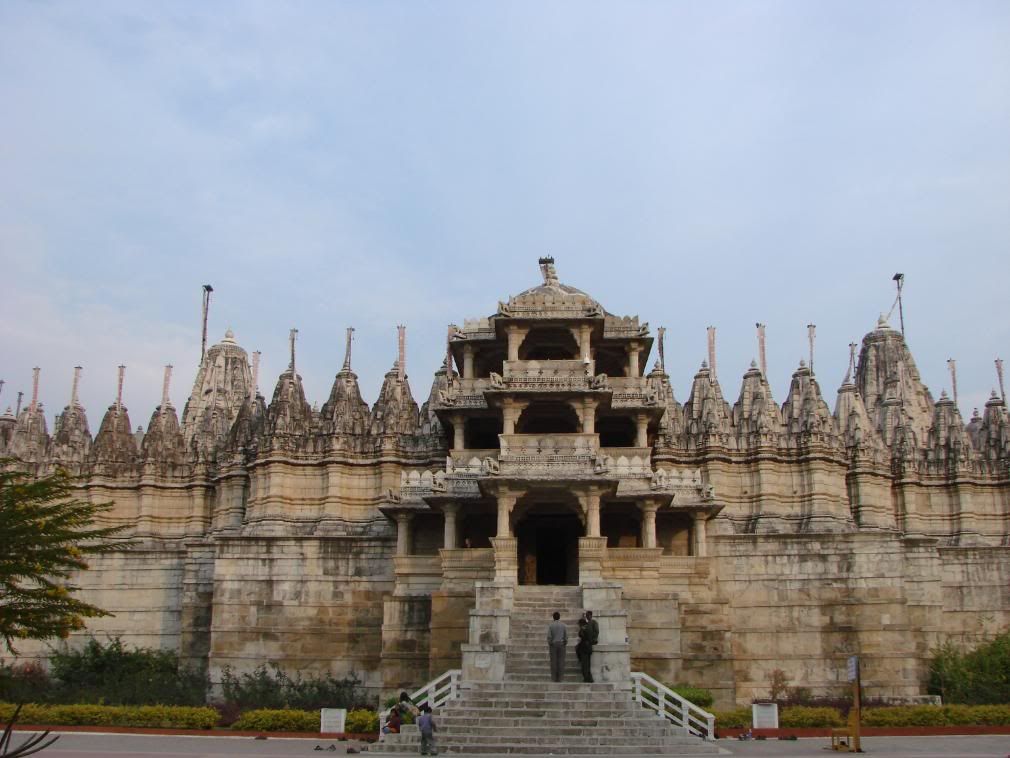

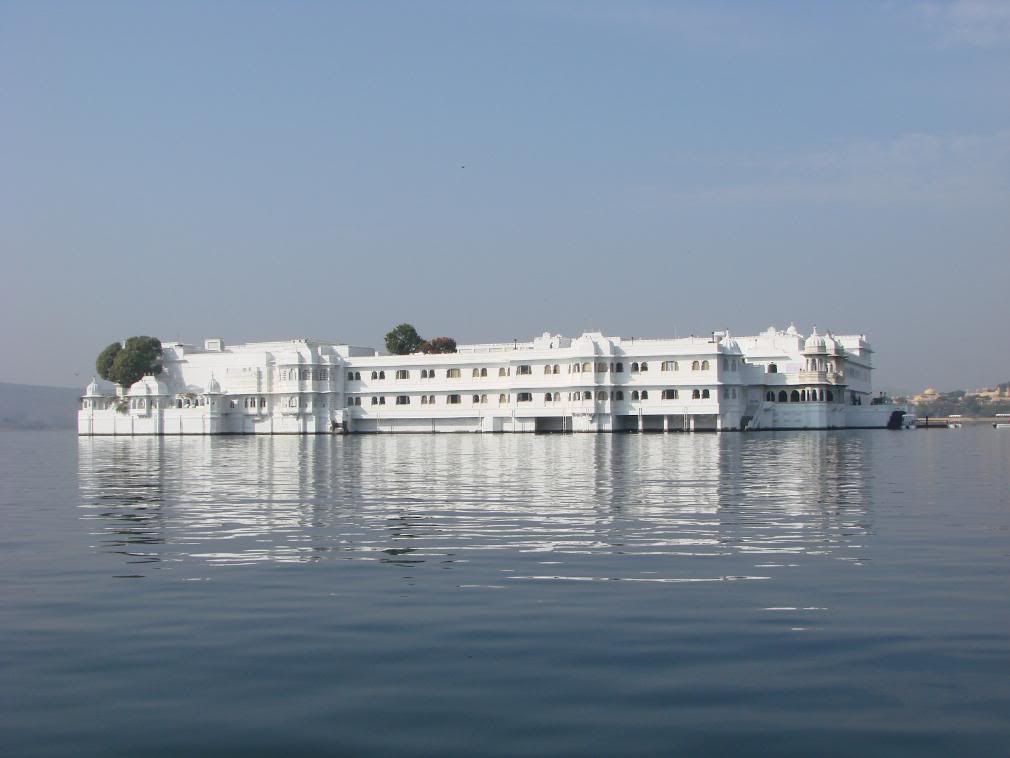
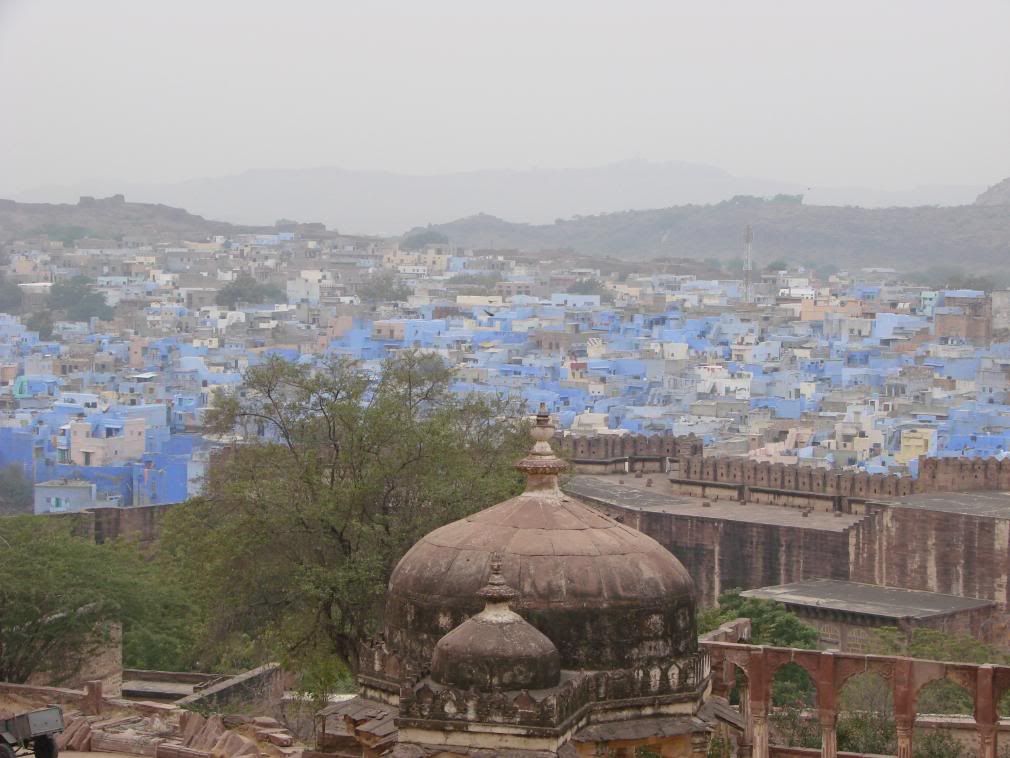
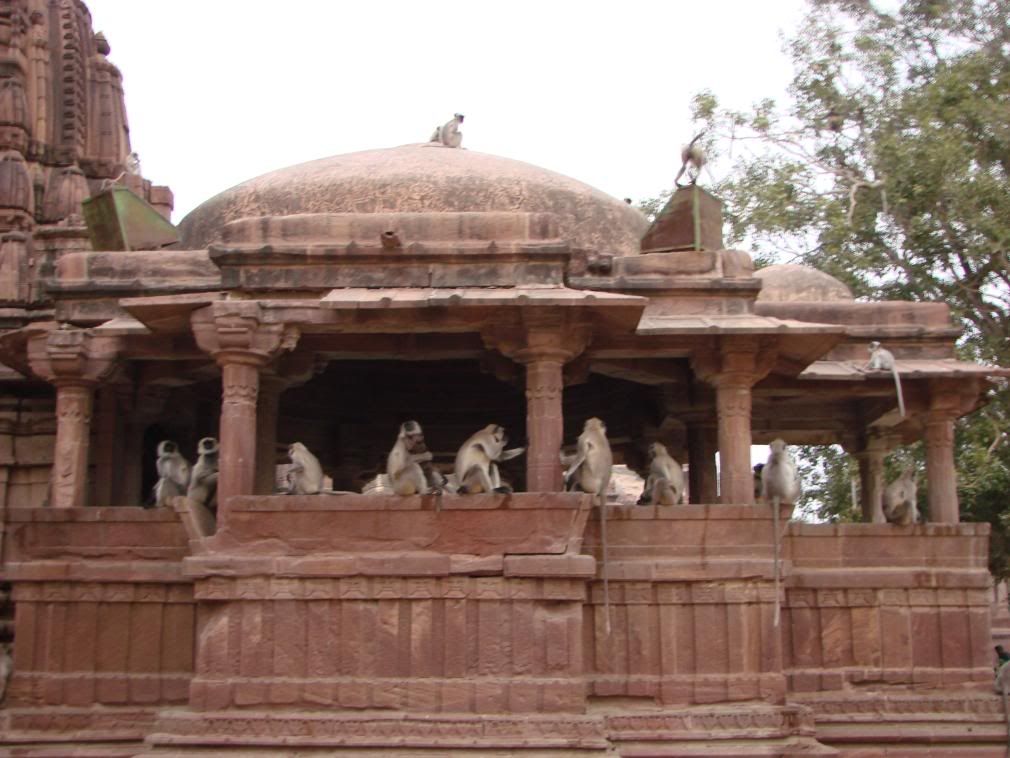
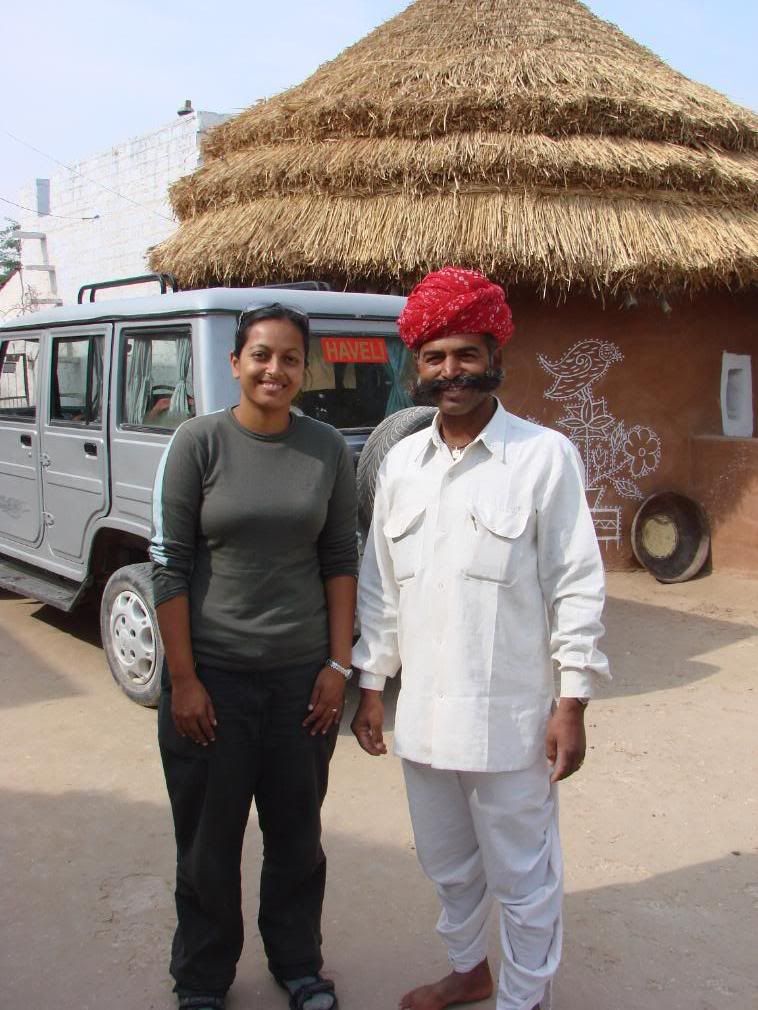





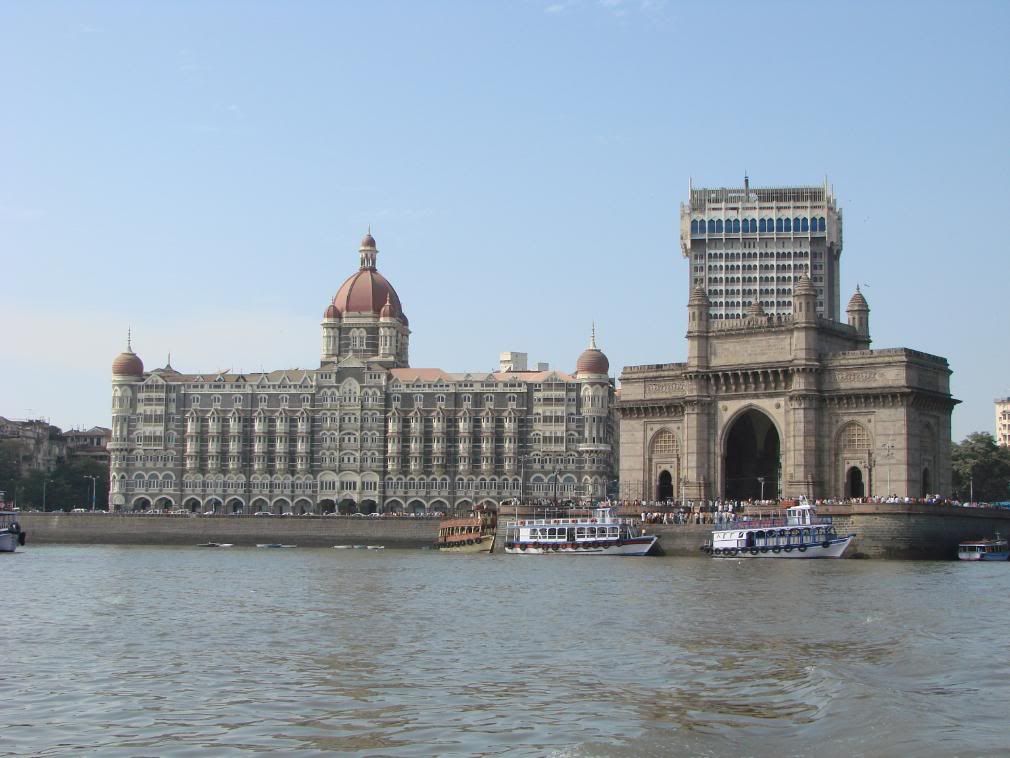
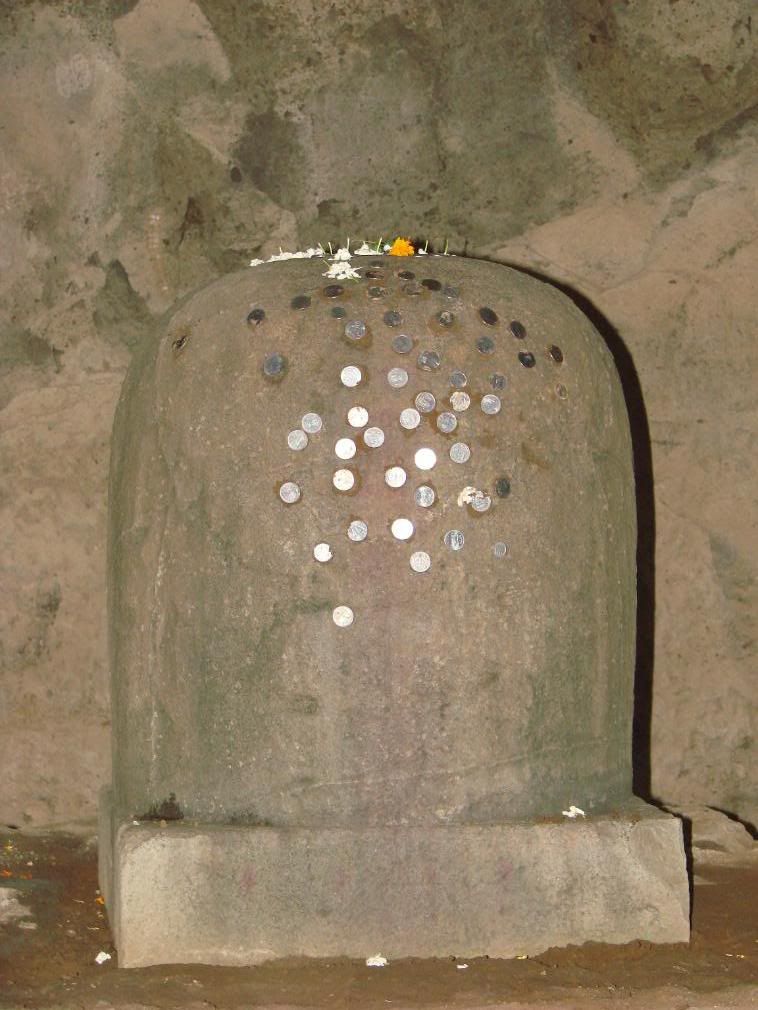
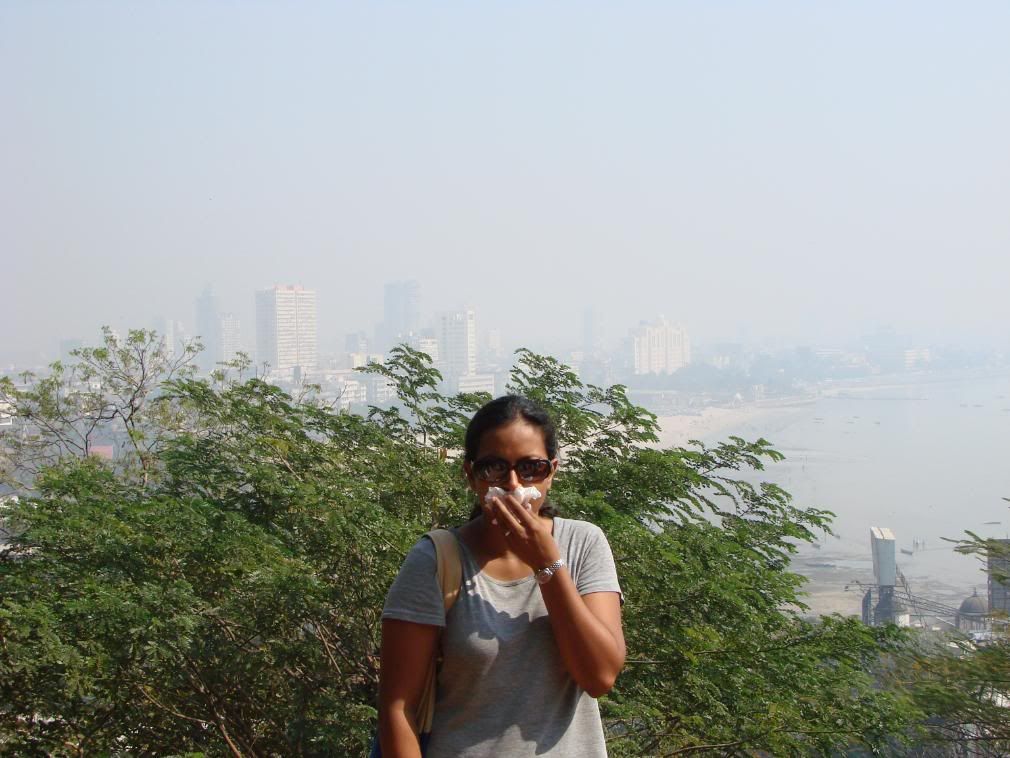
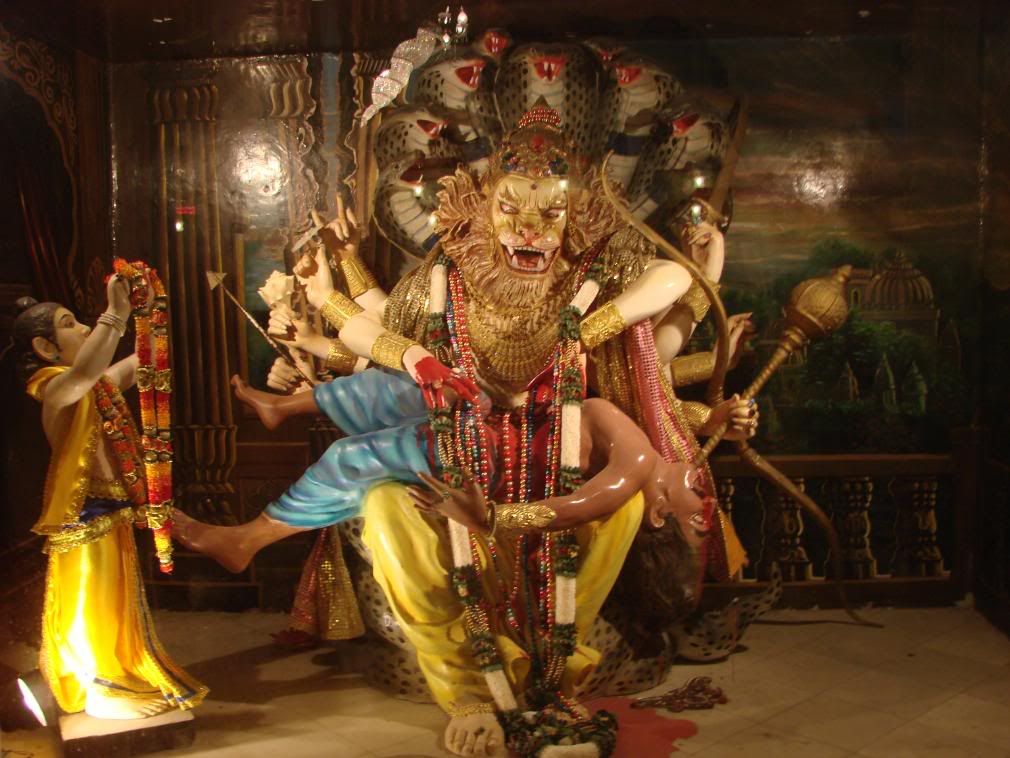
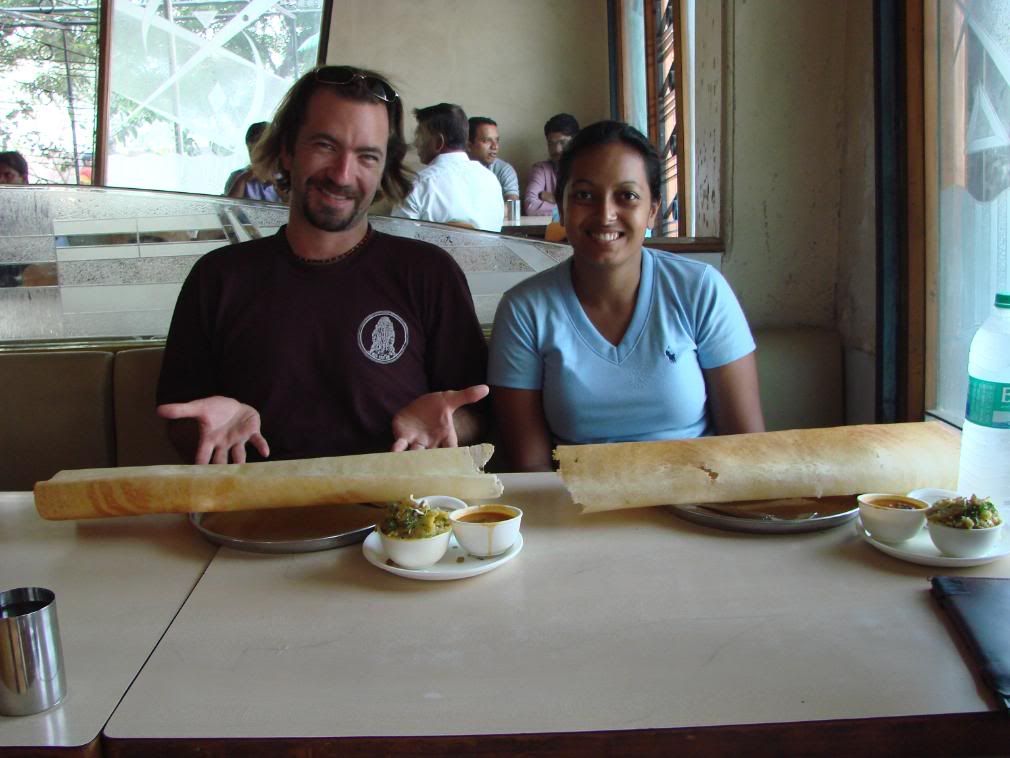
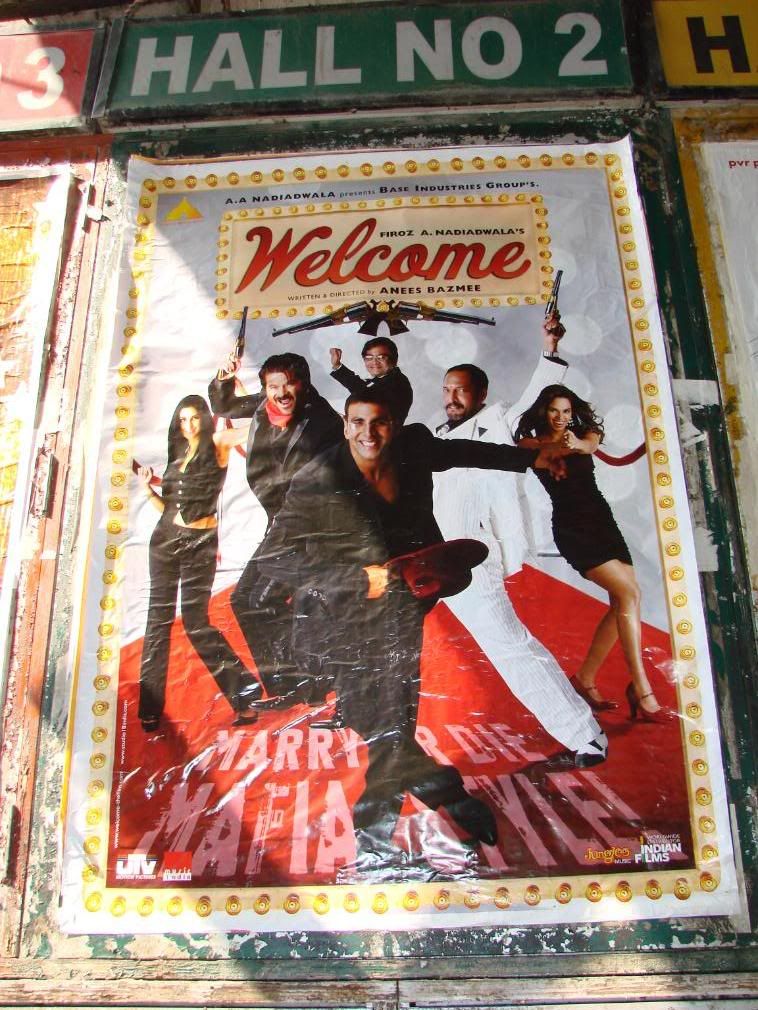
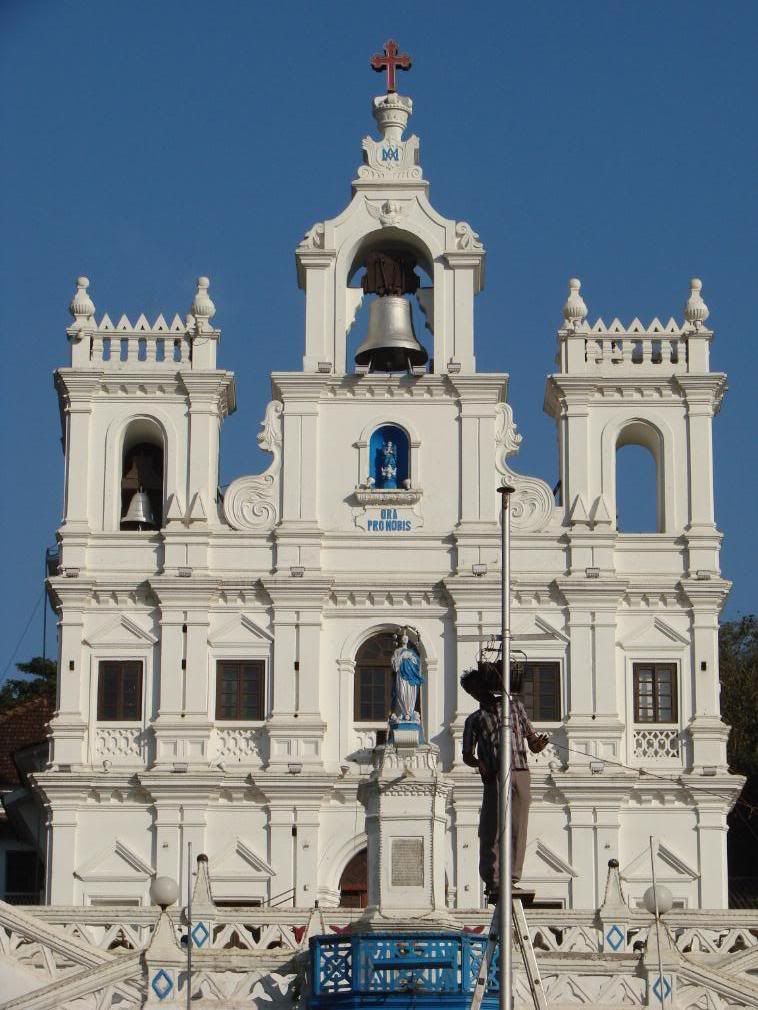
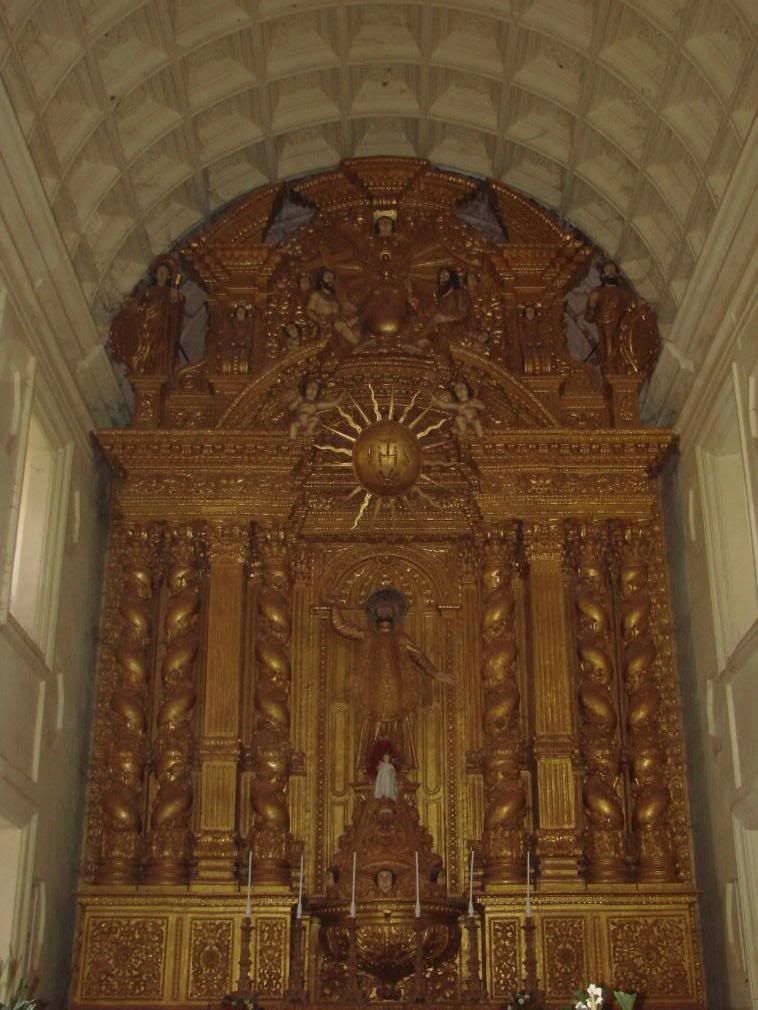

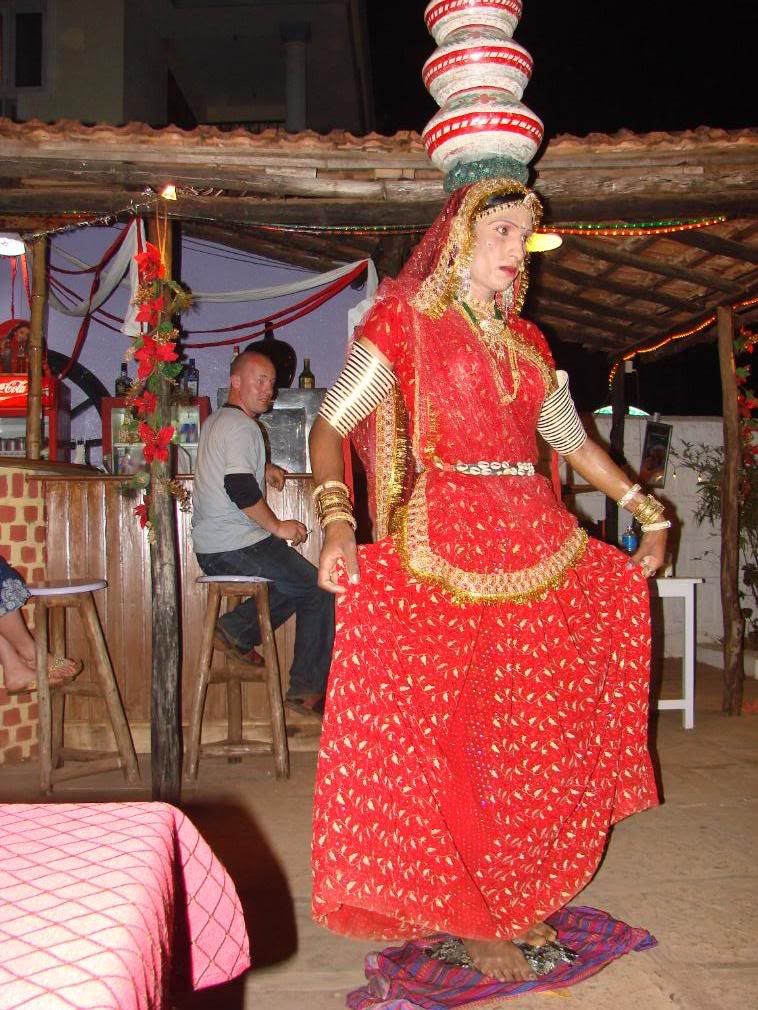
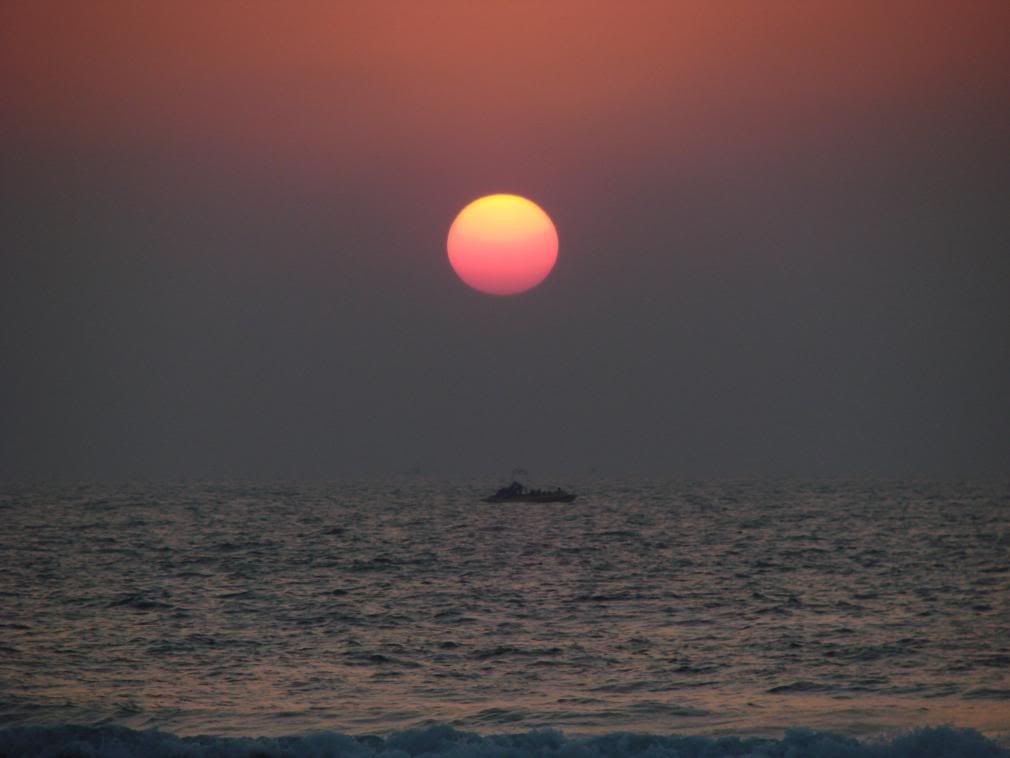
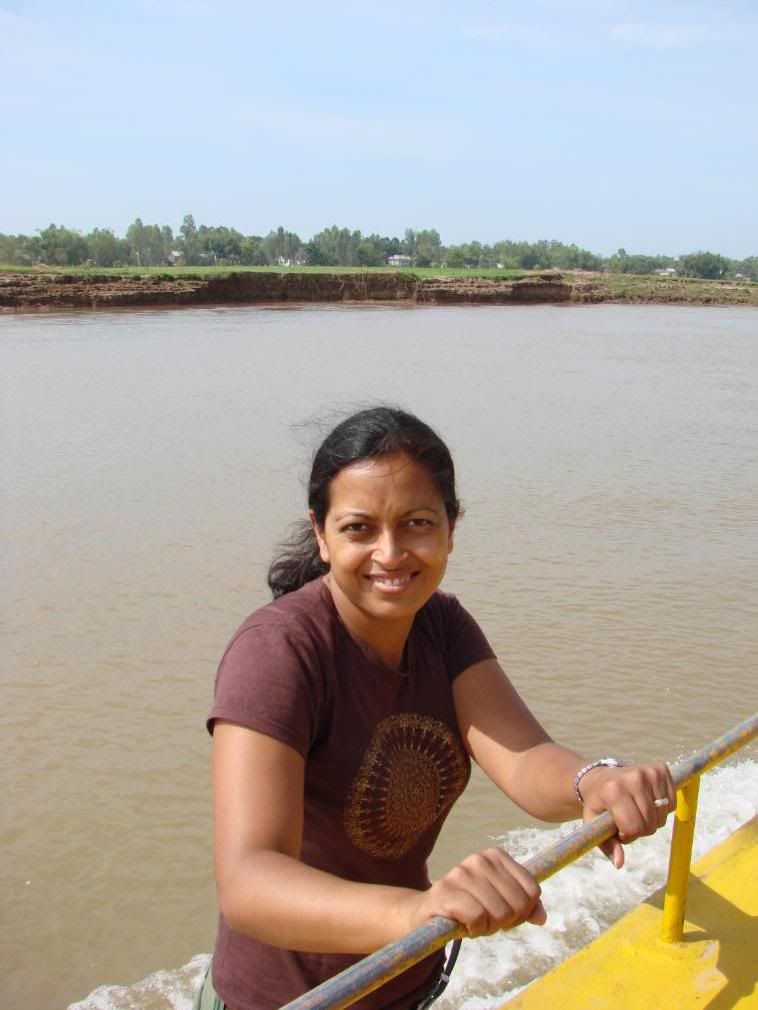 On the way we stopped at an ATM and were pleasantly surprised but slightly disturbed that the currency was U.S. dollars. We strolled along the river, and passed several small temples and dozens of homeless people, mostly children. We also came across "Bug Row", which was a street in the local market that was line with vendors selling all kinds of critters: crickets, tarantulas, grasshoppers, grubs, etc. Jason’s adventurous side came forward but we decided to hold off because we didn’t have the camera with us (and unfornutately never got around to getting a picture).
On the way we stopped at an ATM and were pleasantly surprised but slightly disturbed that the currency was U.S. dollars. We strolled along the river, and passed several small temples and dozens of homeless people, mostly children. We also came across "Bug Row", which was a street in the local market that was line with vendors selling all kinds of critters: crickets, tarantulas, grasshoppers, grubs, etc. Jason’s adventurous side came forward but we decided to hold off because we didn’t have the camera with us (and unfornutately never got around to getting a picture). 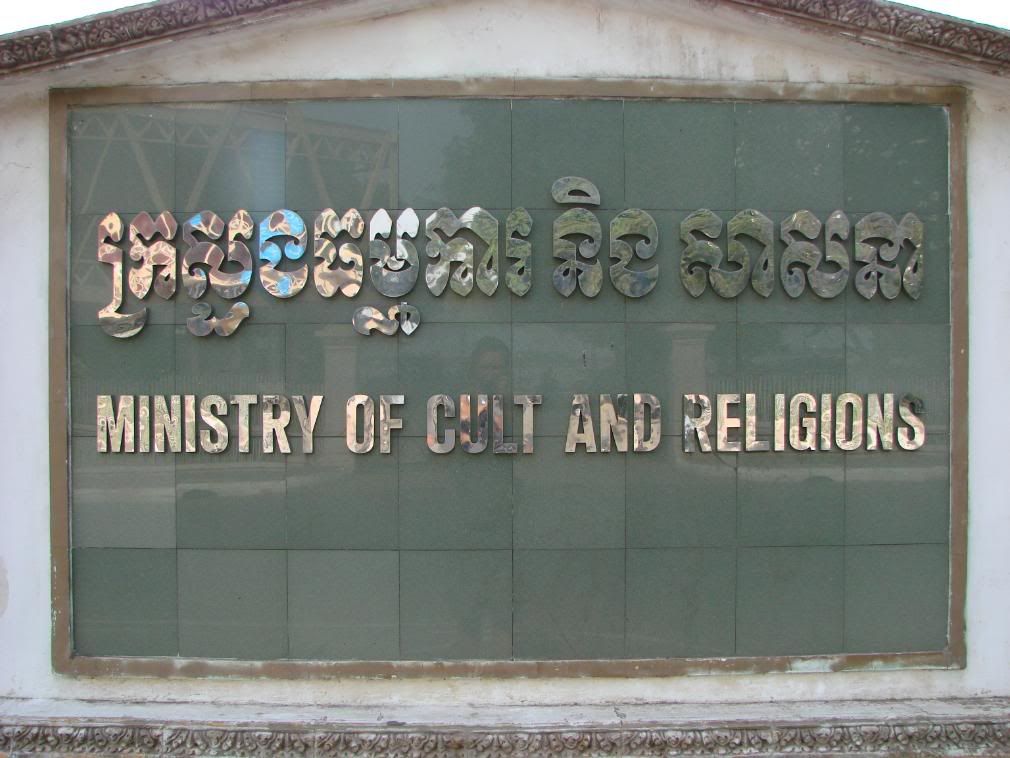 As we meandered through the city, we came across the Ministry of Cult and Religions which Jason found an apt coupling since he sees them as the same thing, but we couldn't go inside. For dinner, we enjoyed one of the local specialties, fish alok, which consisted of a mixture of lemongrass and coconut (basically Thai but milder). We also sampled the Ankor Beer, which was pretty good but no Beer Lao.
As we meandered through the city, we came across the Ministry of Cult and Religions which Jason found an apt coupling since he sees them as the same thing, but we couldn't go inside. For dinner, we enjoyed one of the local specialties, fish alok, which consisted of a mixture of lemongrass and coconut (basically Thai but milder). We also sampled the Ankor Beer, which was pretty good but no Beer Lao.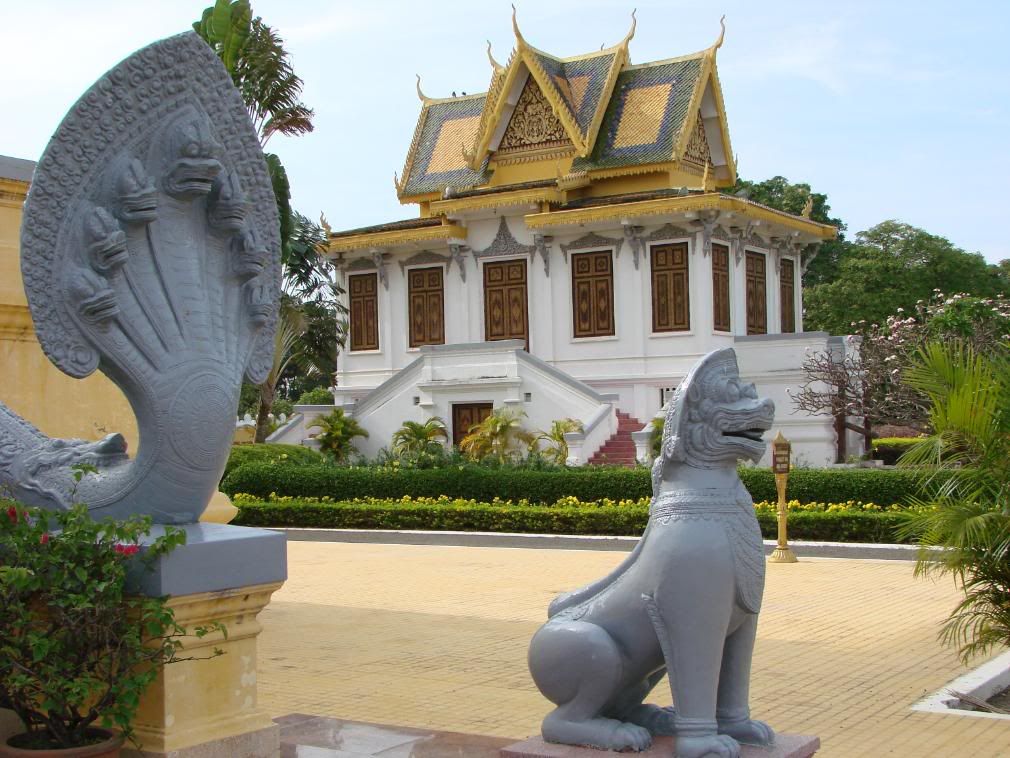 During the game, Jason would get his chance to sample one of the critters as one of the local women dialed in an order for a bag of crickets to go. Ten minutes later, they were sitting in front of him, waiting to be consumed. As he crunched into it, he was reminded of the dried salty sardines we had eaten in the Philippines. Jason managed to win some money despite the chips inexplicably being denominated in kip, the Khmer currency that no one uses except to provide change when less than $1. After collecting his winnings, he decided to head out with a New Yorker named Mark, who’d been living in Phnom Penh for four months. As they conversed, Jason brought up our upcoming travel plans to India, where Mark had spent several months traveling, specifically Ladakh. Jason mentioned that some friends had made a documentary about Buddhist mystics in Ladakh, and it turns out we were separated by just one degree, the inimitable Smitty (Ryan Smith)! We both were in awe as the interconnectedness of our planet planted itself right in our laps. Mark shared some interesting insights into the city which is famous for its lawlessness and frontier zeitgeist (think Wild West).
During the game, Jason would get his chance to sample one of the critters as one of the local women dialed in an order for a bag of crickets to go. Ten minutes later, they were sitting in front of him, waiting to be consumed. As he crunched into it, he was reminded of the dried salty sardines we had eaten in the Philippines. Jason managed to win some money despite the chips inexplicably being denominated in kip, the Khmer currency that no one uses except to provide change when less than $1. After collecting his winnings, he decided to head out with a New Yorker named Mark, who’d been living in Phnom Penh for four months. As they conversed, Jason brought up our upcoming travel plans to India, where Mark had spent several months traveling, specifically Ladakh. Jason mentioned that some friends had made a documentary about Buddhist mystics in Ladakh, and it turns out we were separated by just one degree, the inimitable Smitty (Ryan Smith)! We both were in awe as the interconnectedness of our planet planted itself right in our laps. Mark shared some interesting insights into the city which is famous for its lawlessness and frontier zeitgeist (think Wild West). 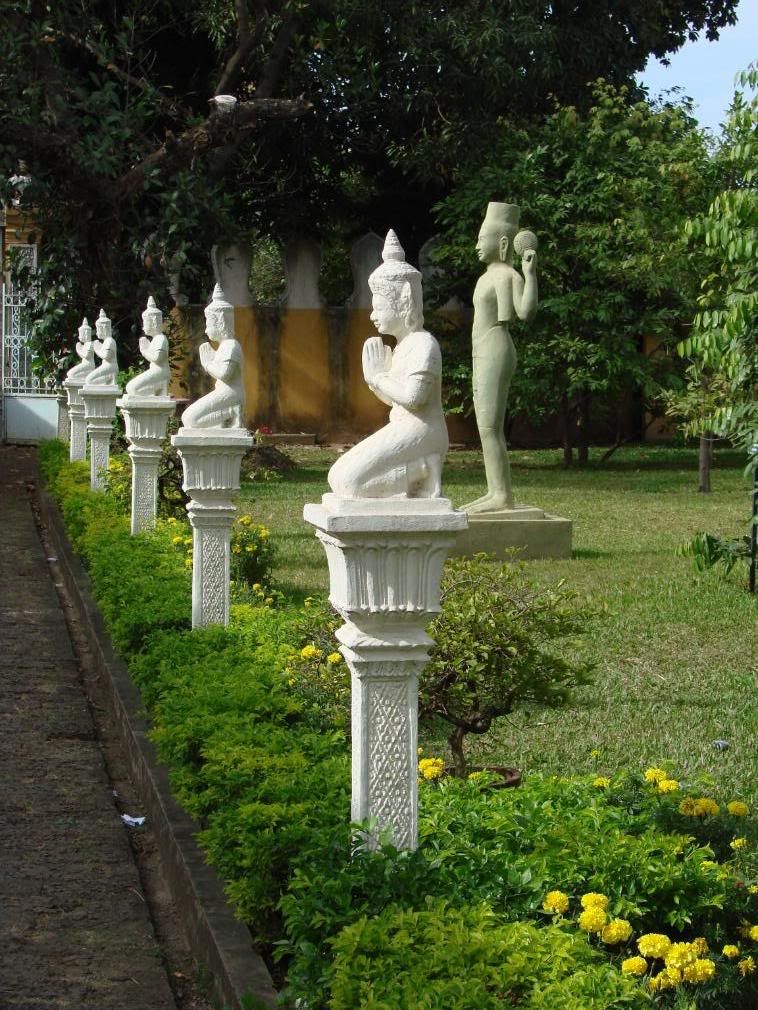 For example, there is one street, which we did not see, that is essentially ‘Prostitute Row’ and is lined with little warehouses filled with girls and boys as young as fourteen that will satisfy even the most depraved tourists. Cambodia is now one of the most popular countries for sex tourism because it is cheaper than Thailand (which is already very cheap) and Vietnam clamped down on the industry; many if not most of the prostitutes working in Cambodia (often having been enslaved) are actually Vietnamese. Jason was barely able to restrain himself when he saw men aged sixty or older holding hands with teenagers. More chillingly, at the hotel at which we were staying, which was huge and packed with backpackers, two tourists had been found dead in their room. Luckily, when we went out to another club, we didn’t witness firsthand this lawlessness and no one pulled their guns out (which is apparently a common occurrence).
For example, there is one street, which we did not see, that is essentially ‘Prostitute Row’ and is lined with little warehouses filled with girls and boys as young as fourteen that will satisfy even the most depraved tourists. Cambodia is now one of the most popular countries for sex tourism because it is cheaper than Thailand (which is already very cheap) and Vietnam clamped down on the industry; many if not most of the prostitutes working in Cambodia (often having been enslaved) are actually Vietnamese. Jason was barely able to restrain himself when he saw men aged sixty or older holding hands with teenagers. More chillingly, at the hotel at which we were staying, which was huge and packed with backpackers, two tourists had been found dead in their room. Luckily, when we went out to another club, we didn’t witness firsthand this lawlessness and no one pulled their guns out (which is apparently a common occurrence).  In 1975, upon their relatively easy defeat of the corrupt Sihanouk’s army, Pol Pot and his group of naïve revolutionaries then set about annihilating their country in order to form a Communist utopia. Their first move was to implement an asinine policy of evacuating all of the major cities and forcing literally everyone into the countryside. The rationale for this policy was that for too long city residents had exploited the farmers. Hundreds of thousands died during this phase alone. Those who survived faced in many cases an even worse fate, as they were stripped of all possessions (money was abolished) and forced into the hardest labor imaginable. One of the slogans often heard by these ‘new people,’ as displaced city residents were called, was ‘nothing is gained if you live, nothing is lost if you die.’ Pol Pot’s own paranoia was projected onto the entire country, as everyone was on guard for fear of being reported as a traitor.
In 1975, upon their relatively easy defeat of the corrupt Sihanouk’s army, Pol Pot and his group of naïve revolutionaries then set about annihilating their country in order to form a Communist utopia. Their first move was to implement an asinine policy of evacuating all of the major cities and forcing literally everyone into the countryside. The rationale for this policy was that for too long city residents had exploited the farmers. Hundreds of thousands died during this phase alone. Those who survived faced in many cases an even worse fate, as they were stripped of all possessions (money was abolished) and forced into the hardest labor imaginable. One of the slogans often heard by these ‘new people,’ as displaced city residents were called, was ‘nothing is gained if you live, nothing is lost if you die.’ Pol Pot’s own paranoia was projected onto the entire country, as everyone was on guard for fear of being reported as a traitor. 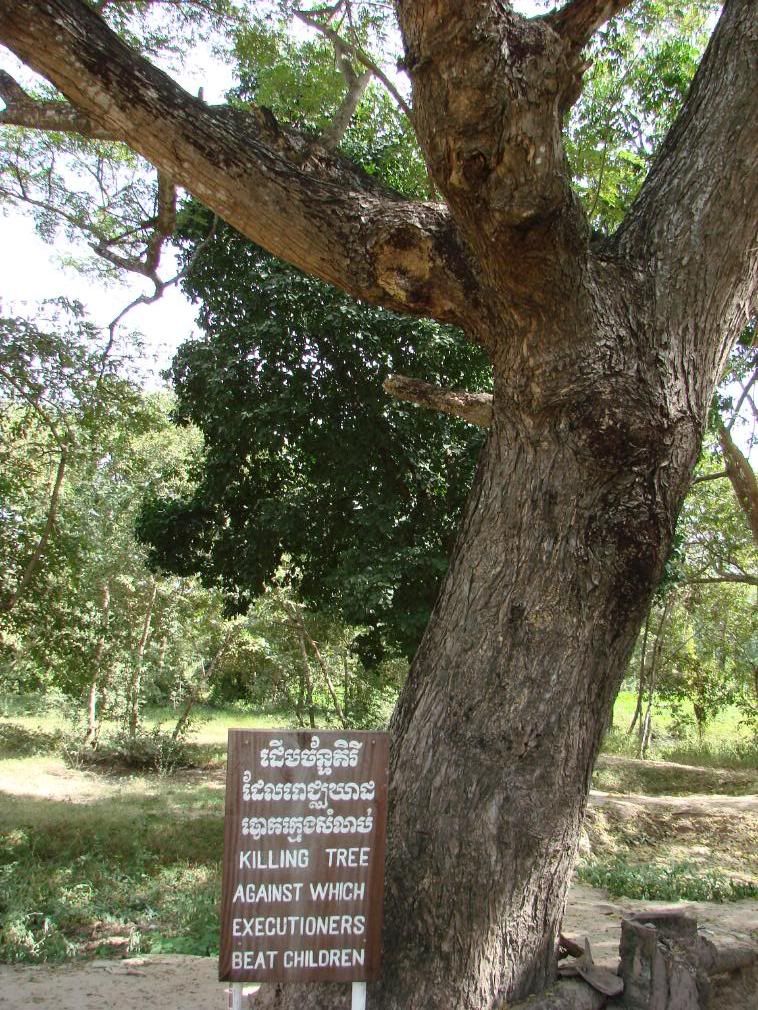 Children were indoctrinated to turn on their parents and even knowing someone who was suspected of minor wrongdoings was punishable by torture and death. Two years into their power, they ignited a full-on war with Vietnam that would ultimately destroy their regime two years later. Although they spent just four years in power, the Khmer Rouge were directly responsible for the deaths of over 1 million people, or about 1/7 of their population.
Children were indoctrinated to turn on their parents and even knowing someone who was suspected of minor wrongdoings was punishable by torture and death. Two years into their power, they ignited a full-on war with Vietnam that would ultimately destroy their regime two years later. Although they spent just four years in power, the Khmer Rouge were directly responsible for the deaths of over 1 million people, or about 1/7 of their population. 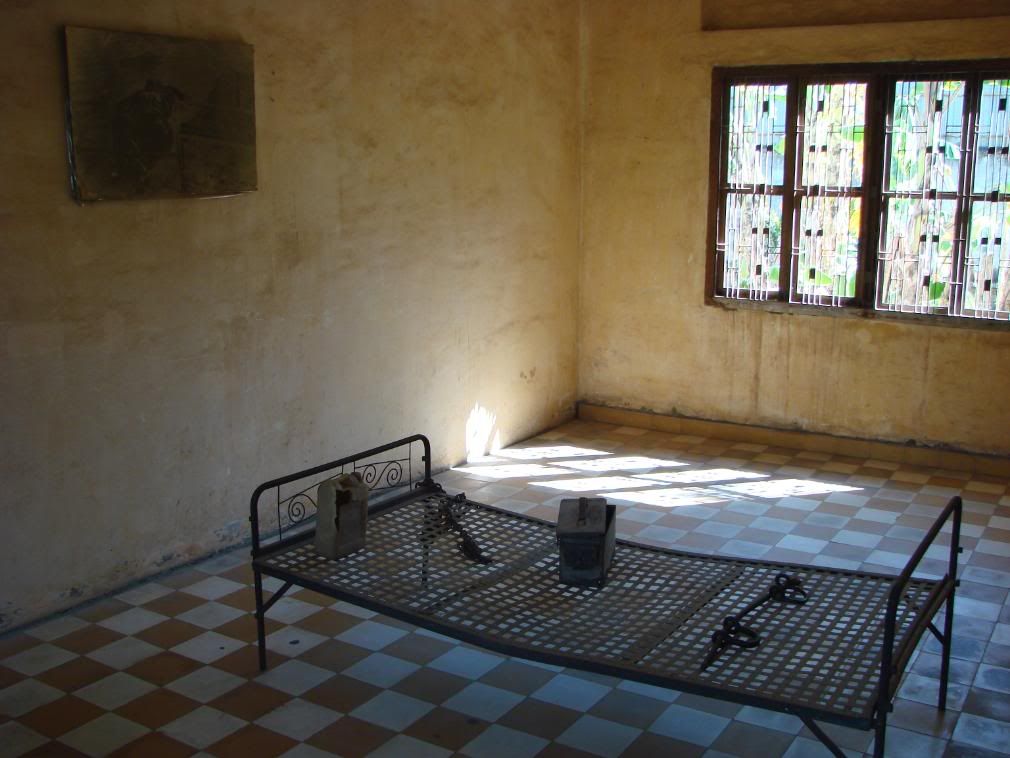 The next stop was Tuol Sleng, or S-21, which was a school that the Khmer Rouge turned into a prison. One three-story building consisted of a series of cells. On the first floor, each room had a single bed in the middle with various implements of torture chained to them. Graphic pictures on the wall showed the corpses that were left to rot in those very same beds. The 2nd and 3rd stories contained smaller cells that were about the size of closets, where other victims were held. The adjacent building contained room after room of portraits of the victims. We slowly moved through these rooms, entranced by the expressions on their faces: fear, resignation, anger, even hope that they might be spared. But of the more than 14,000 residents of S-21, there were just seven survivors. The faces of the child victims were the saddest of all.
The next stop was Tuol Sleng, or S-21, which was a school that the Khmer Rouge turned into a prison. One three-story building consisted of a series of cells. On the first floor, each room had a single bed in the middle with various implements of torture chained to them. Graphic pictures on the wall showed the corpses that were left to rot in those very same beds. The 2nd and 3rd stories contained smaller cells that were about the size of closets, where other victims were held. The adjacent building contained room after room of portraits of the victims. We slowly moved through these rooms, entranced by the expressions on their faces: fear, resignation, anger, even hope that they might be spared. But of the more than 14,000 residents of S-21, there were just seven survivors. The faces of the child victims were the saddest of all.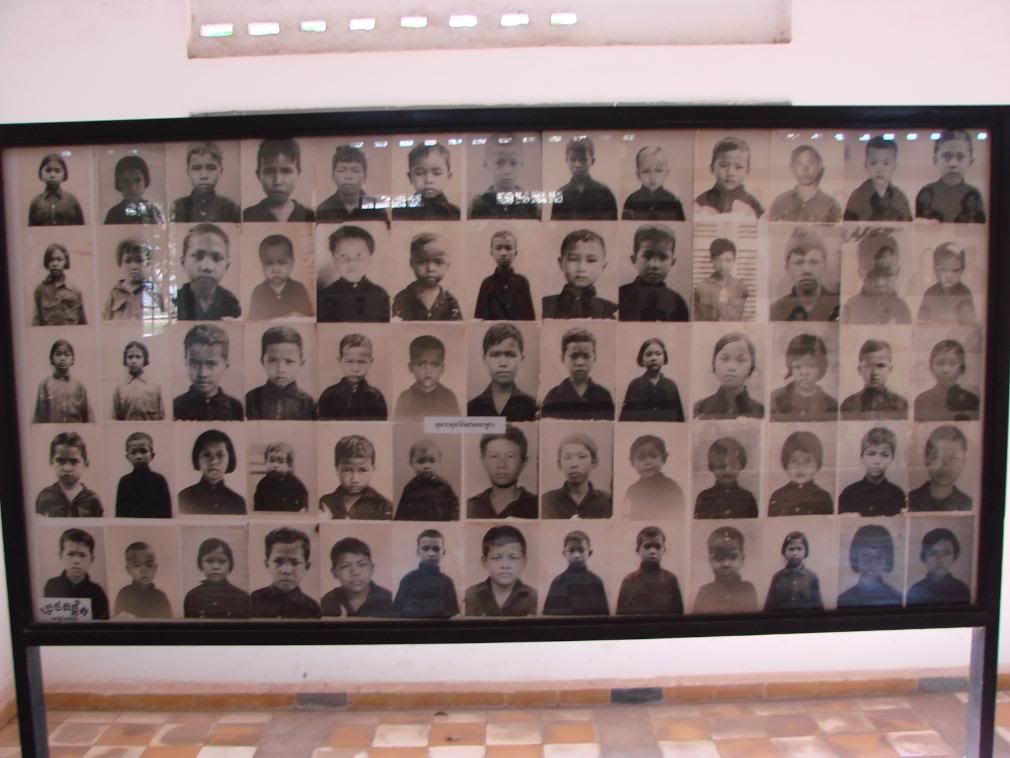 One fascinating aspect of the Khmer Rouge is that they maintained copious records of their victims, including lengthy confessions (some over 200 pages) that were generally extracted by torture. The most informative confessions were from Pol Pot’s inner circle, over half of whom were ultimately purged, even though some of them had been his ‘friends’ for two decades. Somehow, Pol Pot escaped death and lived in hiding and then house arrest until his death in 1998. Astoundingly, based on his comments shortly before his death, ‘everything I did, I did for my country,’ his conscience remained clear. But what’s even more astounding is that, according to Mark, the Khmer Rouge are still in power in much of the more remote areas of Cambodia.
One fascinating aspect of the Khmer Rouge is that they maintained copious records of their victims, including lengthy confessions (some over 200 pages) that were generally extracted by torture. The most informative confessions were from Pol Pot’s inner circle, over half of whom were ultimately purged, even though some of them had been his ‘friends’ for two decades. Somehow, Pol Pot escaped death and lived in hiding and then house arrest until his death in 1998. Astoundingly, based on his comments shortly before his death, ‘everything I did, I did for my country,’ his conscience remained clear. But what’s even more astounding is that, according to Mark, the Khmer Rouge are still in power in much of the more remote areas of Cambodia.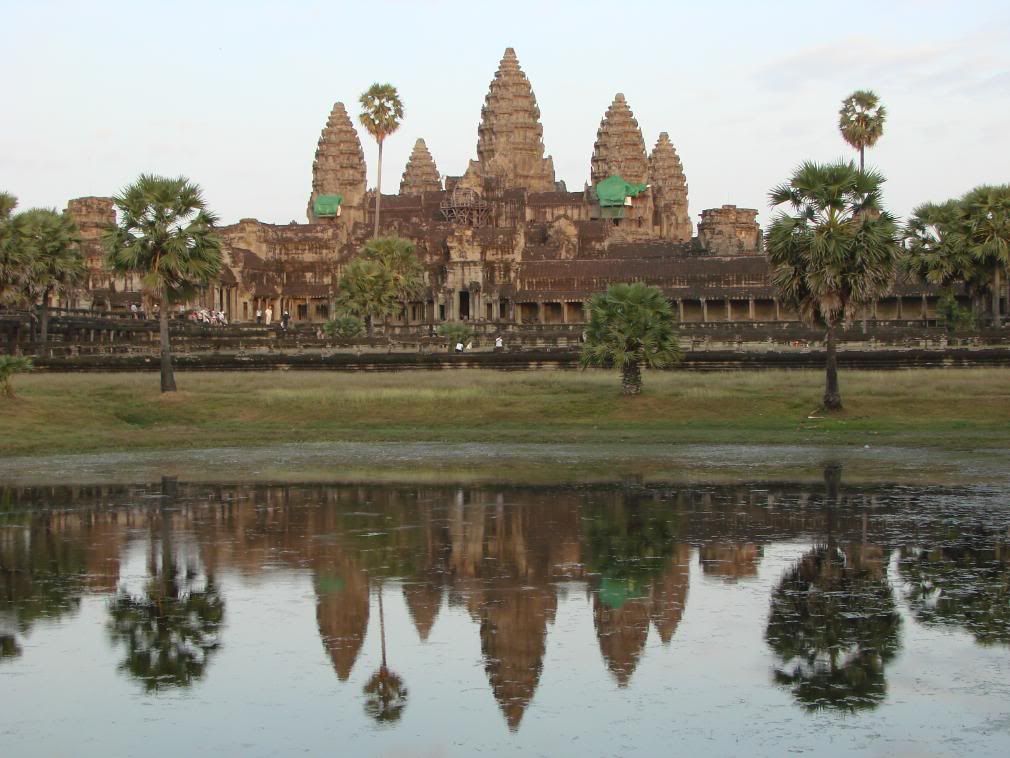 We opted for the three-day pass, which was a bit pricey at $40 but we knew that one day would not be enough and we wanted to take a relaxed pace rather than rush around trying to see everything. Upon our arrival, we purchased a guidebook called Ancient Angkor that we found invaluable in our explorations. Our first stop was Angkor Wat itself; with its triumvirate towers, it is the most well-known of the temples and is a ubiquitous symbol in the Khmer landscape, donning both the flag and the beer.
We opted for the three-day pass, which was a bit pricey at $40 but we knew that one day would not be enough and we wanted to take a relaxed pace rather than rush around trying to see everything. Upon our arrival, we purchased a guidebook called Ancient Angkor that we found invaluable in our explorations. Our first stop was Angkor Wat itself; with its triumvirate towers, it is the most well-known of the temples and is a ubiquitous symbol in the Khmer landscape, donning both the flag and the beer. 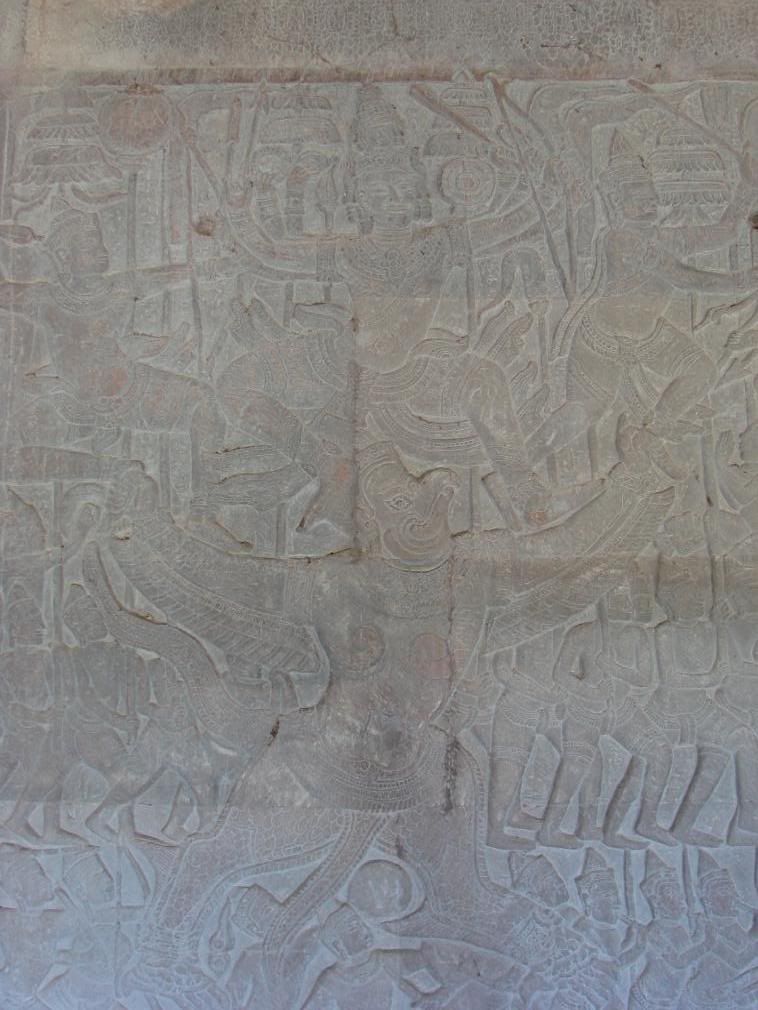 It is truly an amazing structure to behold and one of the most amazing things we’ve ever seen. Pol Pot was reported to have said, when informed that his production goals were impossible to meet, ‘if our people were capable of Angkor, we can do anything.’ Our amazement only grew when we entered the temple, as every wall was covered with detailed carvings called bas-reliefs. Most of the scenes were from Hindu mythology, including the Ramayana and Mahabharata.
It is truly an amazing structure to behold and one of the most amazing things we’ve ever seen. Pol Pot was reported to have said, when informed that his production goals were impossible to meet, ‘if our people were capable of Angkor, we can do anything.’ Our amazement only grew when we entered the temple, as every wall was covered with detailed carvings called bas-reliefs. Most of the scenes were from Hindu mythology, including the Ramayana and Mahabharata. 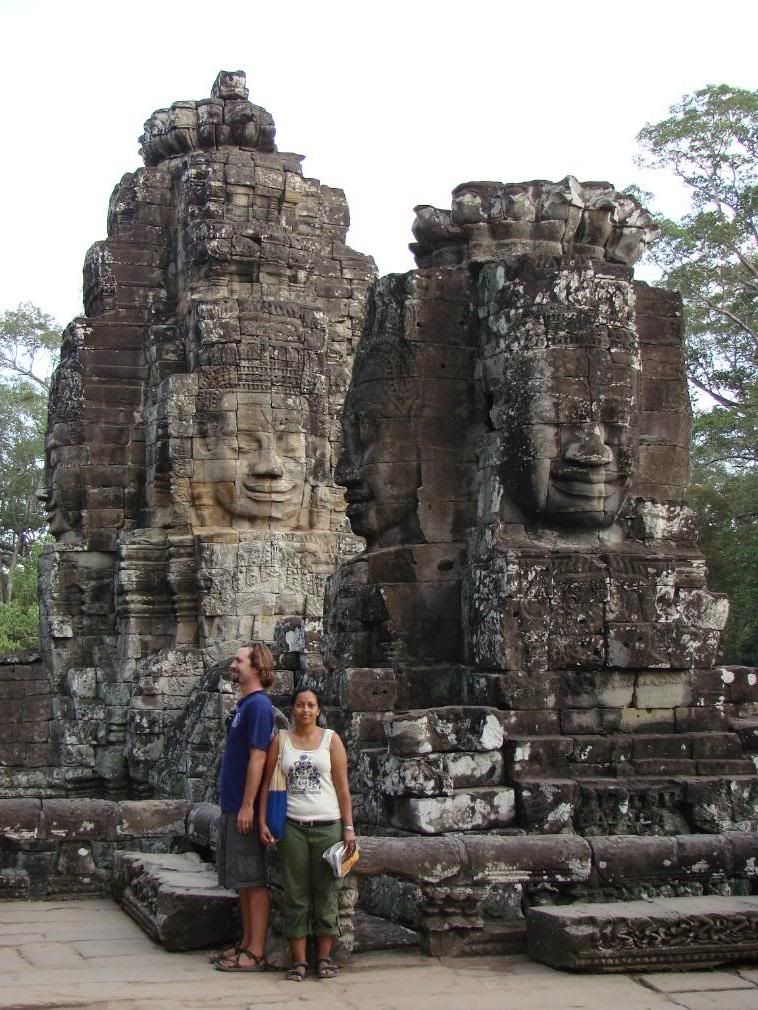 We lost count of the faces whose eyes seemed to follow us throughout the temple. We spent a couple more hours there and before we knew it the day was nearly over. For sunset, we reluctantly opted to join the crowds that gather each evening at a hilltop temple. On our way we stopped at both the Elephant and Leper King Terraces. After ascending the big hill, we had to climb up these huge steps that were so steep we had to use our hands.
We lost count of the faces whose eyes seemed to follow us throughout the temple. We spent a couple more hours there and before we knew it the day was nearly over. For sunset, we reluctantly opted to join the crowds that gather each evening at a hilltop temple. On our way we stopped at both the Elephant and Leper King Terraces. After ascending the big hill, we had to climb up these huge steps that were so steep we had to use our hands. 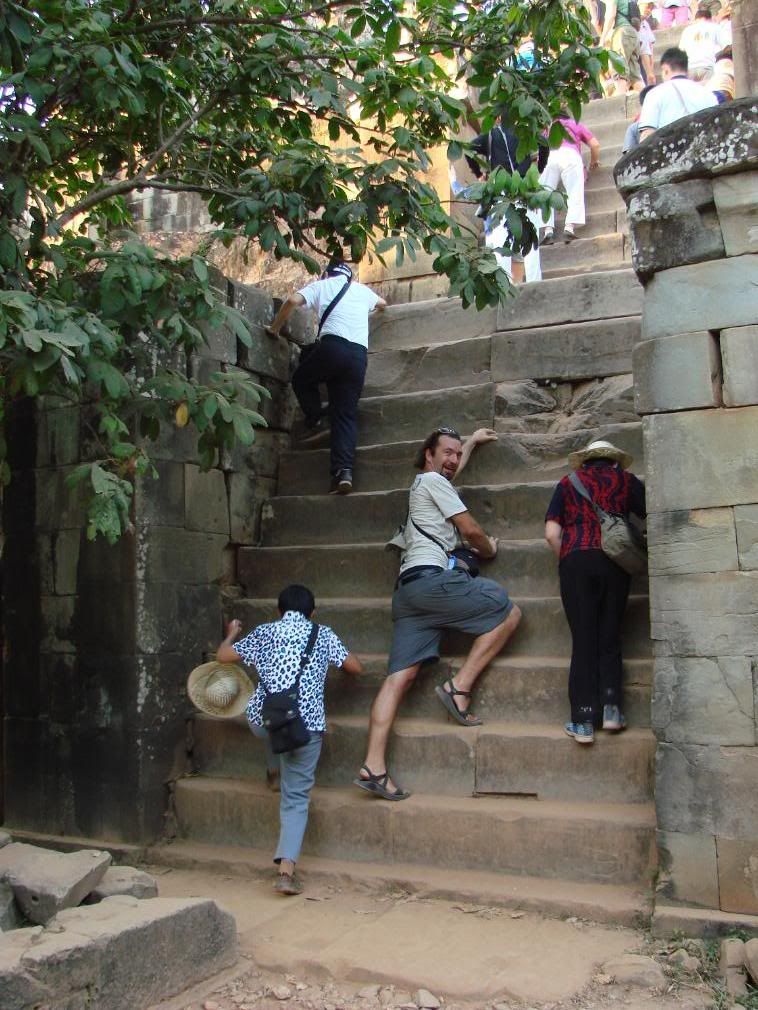 The sun setting behind the temple was nice and we got a good view of Angkor Wat from afar.
The sun setting behind the temple was nice and we got a good view of Angkor Wat from afar. 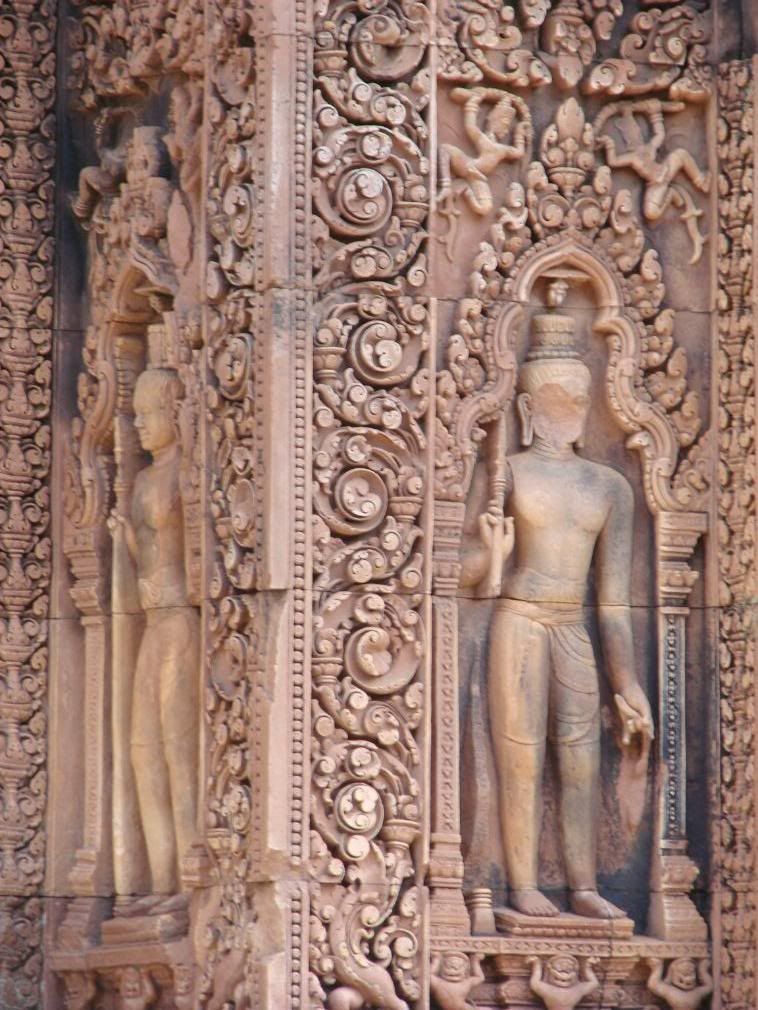 Along the way, we passed many villages, some of which had signs documenting some sort of adoption program by foreigners, most of whom were Americans. It was sad to see yet again dozens of beggin children, and as we were walking to one of the temples, one of them approached us so we gave some of our bananas to her. We hadn’t finished eating the remaining half when another girl approached us. When we offered her bananas, she exclaimed, "I’m not a monkey"(!) Needless to say, she went away empty-handed.
Along the way, we passed many villages, some of which had signs documenting some sort of adoption program by foreigners, most of whom were Americans. It was sad to see yet again dozens of beggin children, and as we were walking to one of the temples, one of them approached us so we gave some of our bananas to her. We hadn’t finished eating the remaining half when another girl approached us. When we offered her bananas, she exclaimed, "I’m not a monkey"(!) Needless to say, she went away empty-handed.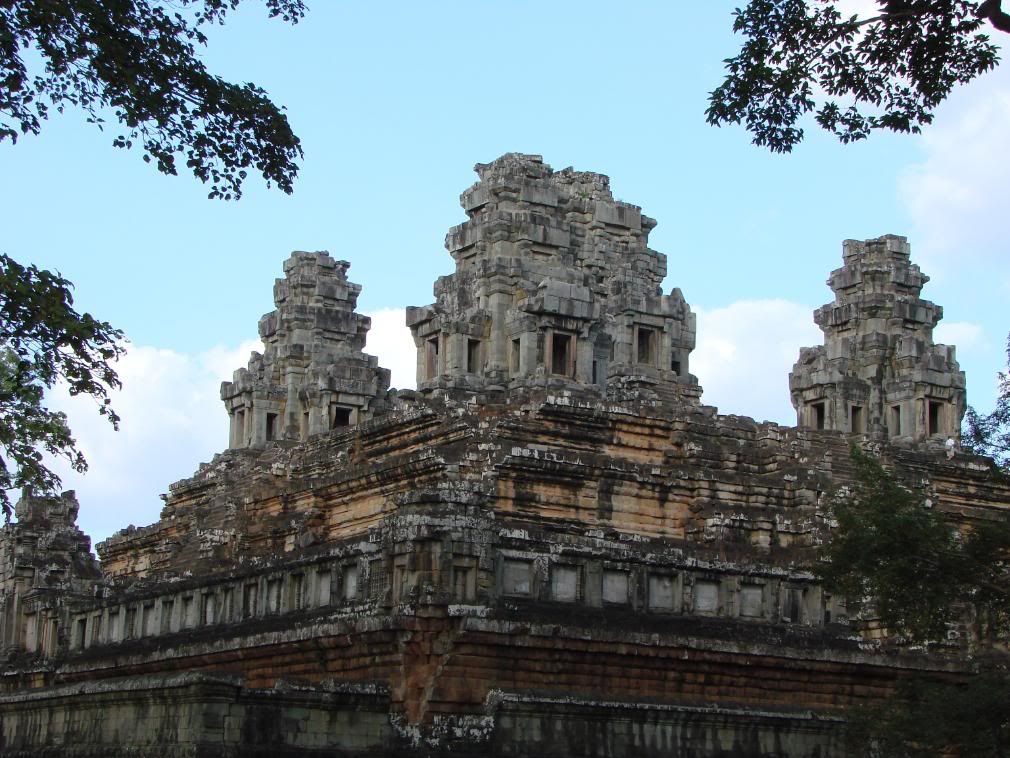 The center of the silver grill had a slab of lard on it which melted and marinated the meat surrounding it. The barbeque was silver and dome shaped so that the meat could be on it. We also enjoyed some Beer Lao and then biked home at a reasonable hour yet we somehow didn’t go to bed until close to midnight. Thus, when the alarm sounded at 5am, we were too tired to get out of bed and ride our bikes to see the sunrise. We got up around eight instead and got ready for a leisurely day of biking. We noticed a wrench on Jason’s bike, which was parked in front of the guesthouse, and then he realized the seat position was lower and the seat had mysteriously suffered a broken shock, making it very uncomfortable to ride. Actually it wasn’t much of a mystery as we knew the seat had been replaced with a broken one. We talked to the guesthouse manager who said the wrench was his but wasn’t sure what had happened to the seat.
The center of the silver grill had a slab of lard on it which melted and marinated the meat surrounding it. The barbeque was silver and dome shaped so that the meat could be on it. We also enjoyed some Beer Lao and then biked home at a reasonable hour yet we somehow didn’t go to bed until close to midnight. Thus, when the alarm sounded at 5am, we were too tired to get out of bed and ride our bikes to see the sunrise. We got up around eight instead and got ready for a leisurely day of biking. We noticed a wrench on Jason’s bike, which was parked in front of the guesthouse, and then he realized the seat position was lower and the seat had mysteriously suffered a broken shock, making it very uncomfortable to ride. Actually it wasn’t much of a mystery as we knew the seat had been replaced with a broken one. We talked to the guesthouse manager who said the wrench was his but wasn’t sure what had happened to the seat. 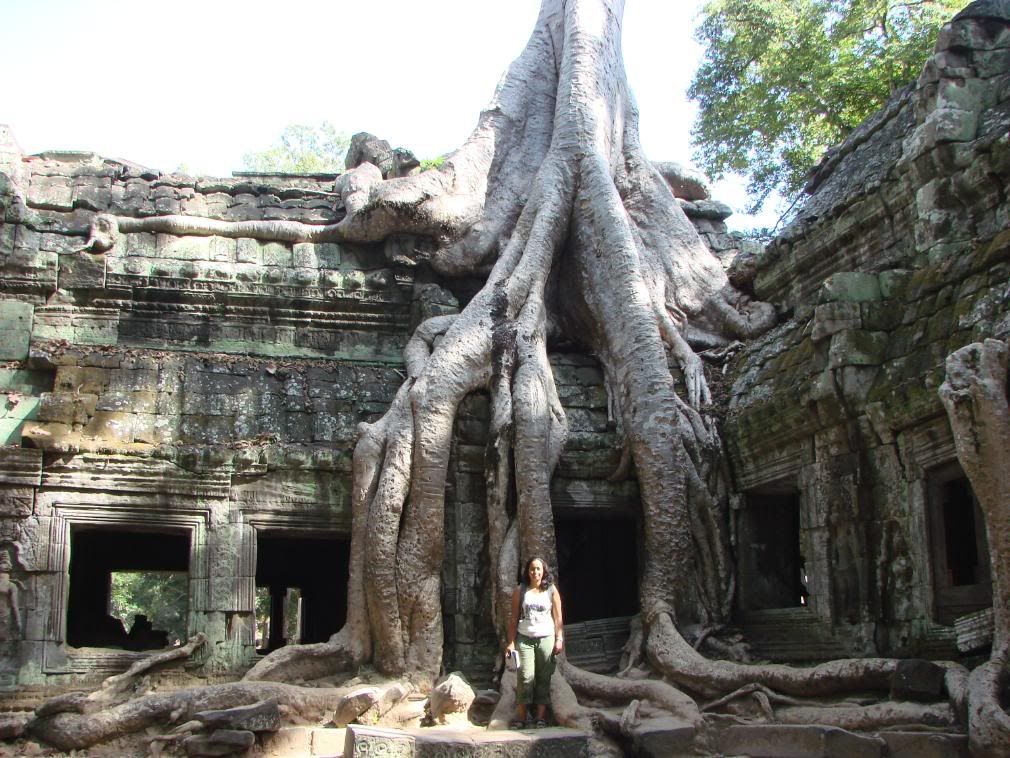 Fortunately we got a replacement without any hassle and then rode off to the Wats. It was a beautiful day with clear skies and a nice wind that kept us cool. This continued the pattern that every time we rent bikes we have great days. The highlight of the day was Ta Prohm, which had lots of trees growing right out of the ruins. At the same time, we were disappointed that some of the temples were in pretty bad shape, considering how much revenue is received each year from tourism. It was even more frustrating because we had received false information that the Temples were owned by the Vietnamese! That evening, we had planned to cap our stay in Siem Reap with a classical music concert that is held at the local children’s hospital every Saturday night. However, when we showed the guesthouse manager the flier, he informed us that it was actually Sunday. This means we had been off by a day for the past week…doh!
Fortunately we got a replacement without any hassle and then rode off to the Wats. It was a beautiful day with clear skies and a nice wind that kept us cool. This continued the pattern that every time we rent bikes we have great days. The highlight of the day was Ta Prohm, which had lots of trees growing right out of the ruins. At the same time, we were disappointed that some of the temples were in pretty bad shape, considering how much revenue is received each year from tourism. It was even more frustrating because we had received false information that the Temples were owned by the Vietnamese! That evening, we had planned to cap our stay in Siem Reap with a classical music concert that is held at the local children’s hospital every Saturday night. However, when we showed the guesthouse manager the flier, he informed us that it was actually Sunday. This means we had been off by a day for the past week…doh! 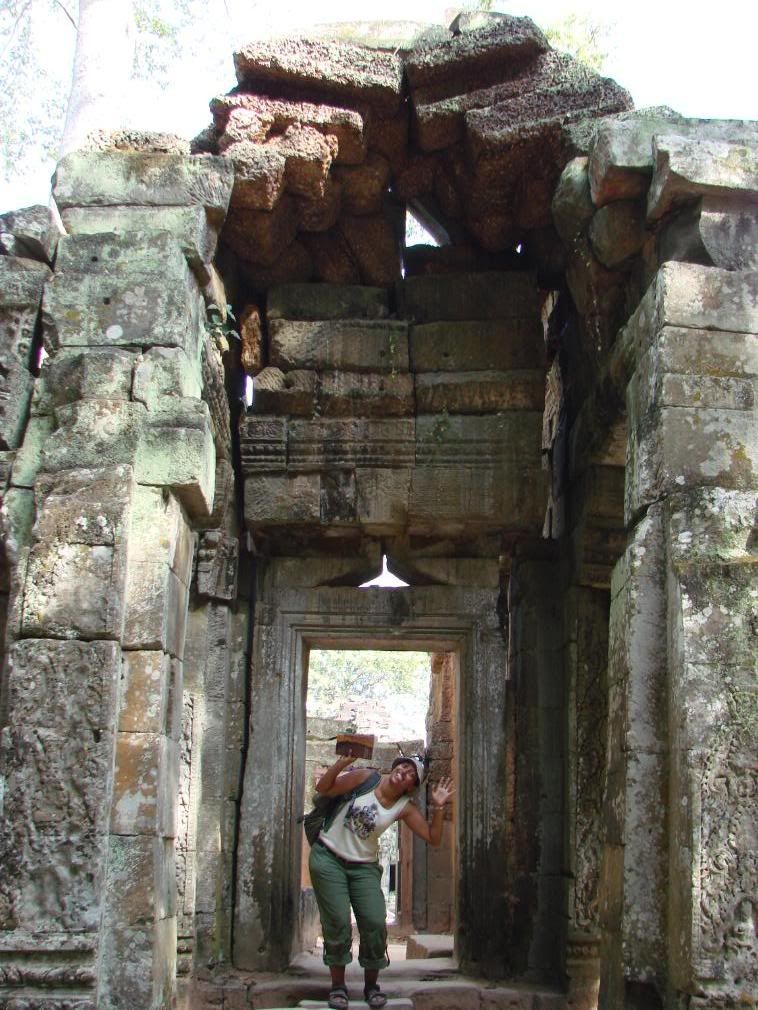 At first, it was just dust on the bags, but after several toilet stops, the dust became mud. The one in the very front got the worst of it, which by the end had a layer of toxic mud caked onto it. Other passengers commented how sorry they felt for the owner who just happened to be Jason. When one young female dolt made the completely asinine and insensitive remark, "I hope no one has anything valuable in their bag" as she proceeded to walk all over them, Jason had to once again summon all his restraint in order not to push her off the bus. At this point Jason would like to mention that he is keeping a record of the most annoying people we’ve met on our trip and she will no doubt occupy a prime spot.
At first, it was just dust on the bags, but after several toilet stops, the dust became mud. The one in the very front got the worst of it, which by the end had a layer of toxic mud caked onto it. Other passengers commented how sorry they felt for the owner who just happened to be Jason. When one young female dolt made the completely asinine and insensitive remark, "I hope no one has anything valuable in their bag" as she proceeded to walk all over them, Jason had to once again summon all his restraint in order not to push her off the bus. At this point Jason would like to mention that he is keeping a record of the most annoying people we’ve met on our trip and she will no doubt occupy a prime spot.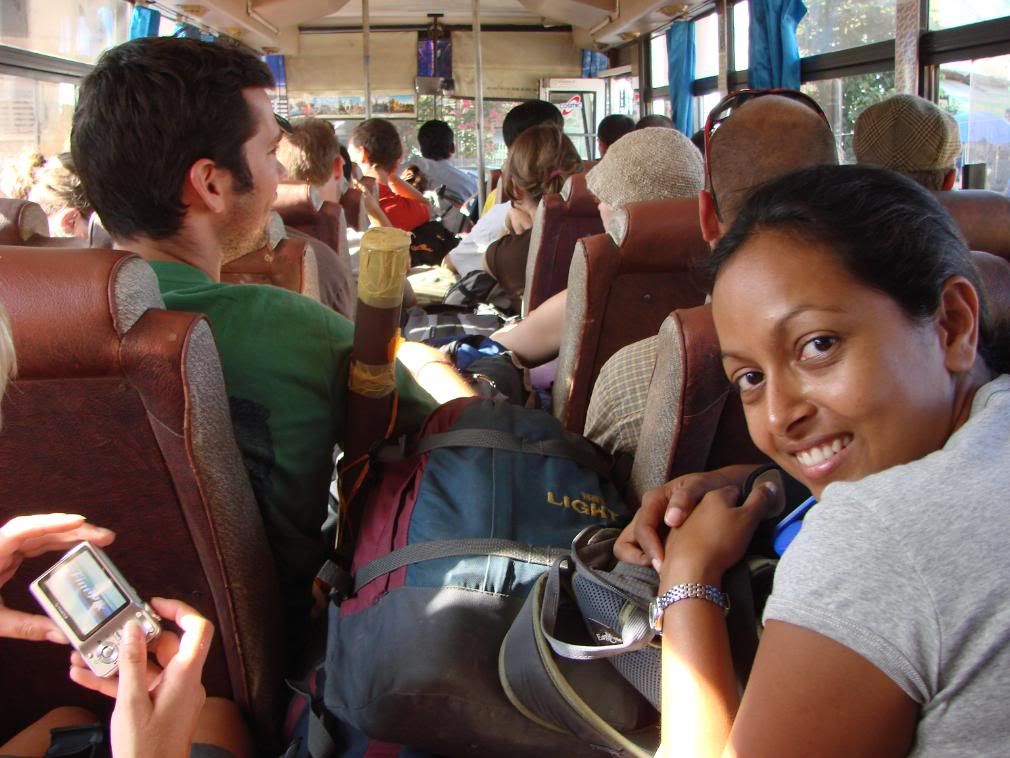 While waiting we watched in disgust as a young boy, probably the age of 5 or 6, was holding a baby strapped to him like a beat up rag-doll. He almost dropped the baby numerous times and his gap-toothed grin seemed to widen with each near drop. Jason wanted to reach out and throttle him but we just had to look the other way. We wondered why these kids didn’t sell bottles of water or something useful instead of just begging for money. After waiting for so long, we were relieved to get onto a bus that actually was air conditioned and drove for 4 more hours to finally reach Bangkok. The total trip took 13 hours but felt like 31 although it could have been worse we figured after seeing this.
While waiting we watched in disgust as a young boy, probably the age of 5 or 6, was holding a baby strapped to him like a beat up rag-doll. He almost dropped the baby numerous times and his gap-toothed grin seemed to widen with each near drop. Jason wanted to reach out and throttle him but we just had to look the other way. We wondered why these kids didn’t sell bottles of water or something useful instead of just begging for money. After waiting for so long, we were relieved to get onto a bus that actually was air conditioned and drove for 4 more hours to finally reach Bangkok. The total trip took 13 hours but felt like 31 although it could have been worse we figured after seeing this.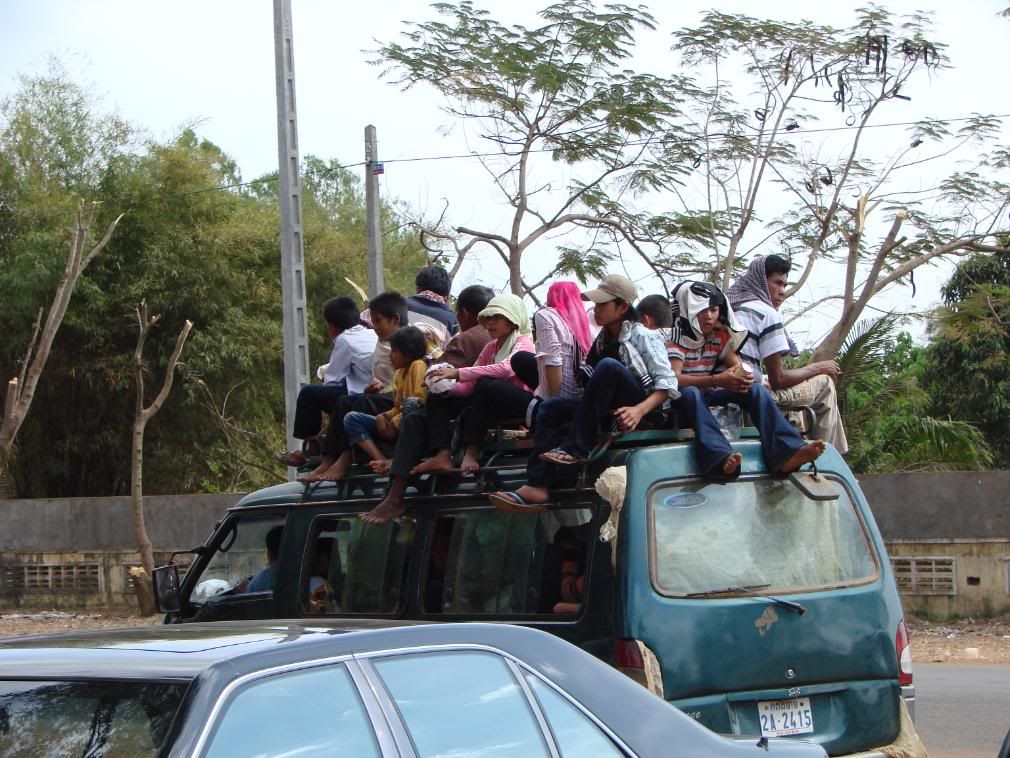 We imagined taking this bus the other way and how awful it must be for people to endure this ride and then be greeted in Cambodia by the insanity at the bus station. Other travelers we’d met had their entire stays in Cambodia ruined because of a negative chain-reaction, like we had experienced in Vietnam. If any of you plan to head to Siem Reap from Thailand, we highly recommend you take the flight rather than risk ruining your entire perceptions of what will hopefully once again be a great country.
We imagined taking this bus the other way and how awful it must be for people to endure this ride and then be greeted in Cambodia by the insanity at the bus station. Other travelers we’d met had their entire stays in Cambodia ruined because of a negative chain-reaction, like we had experienced in Vietnam. If any of you plan to head to Siem Reap from Thailand, we highly recommend you take the flight rather than risk ruining your entire perceptions of what will hopefully once again be a great country.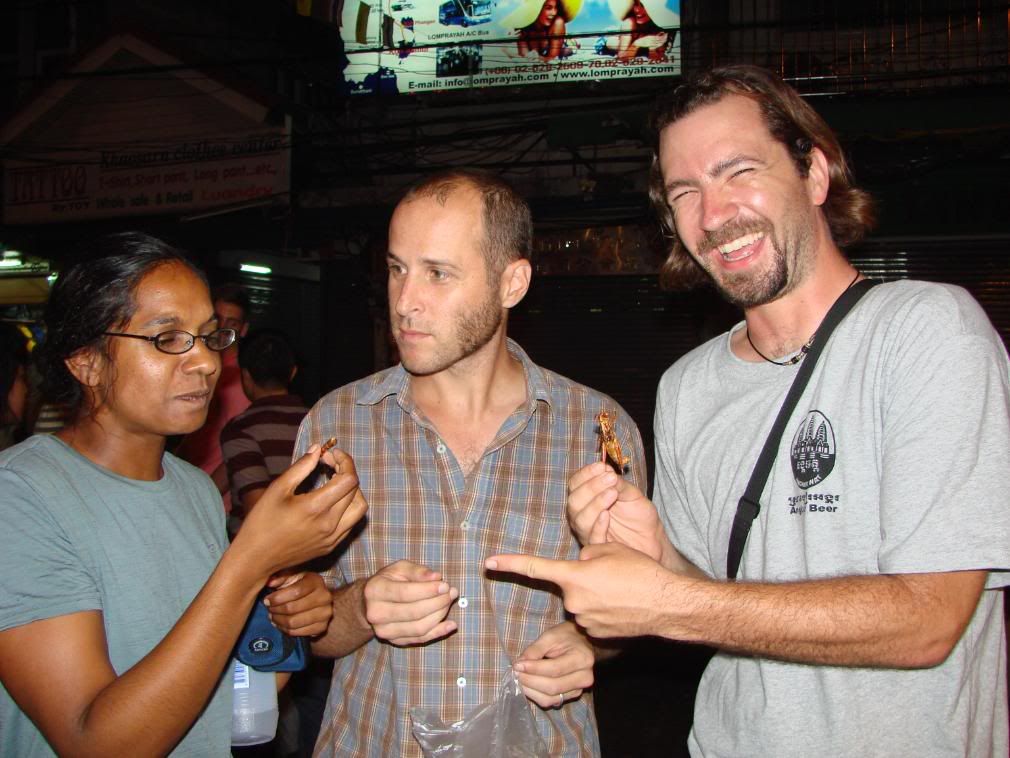 ‘We’ in this instance doesn’t include Priti, as she refused to partake in the exotic snacks. Sapna was enthusiastic but quickly lost it after crunching into her first critter. Jason and Paul chomped on the roasted roaches, grubs and grasshoppers and Jason even got another order of the latter, which he claimed tasted like soy-flavored potato crisps. Also, his distaste for roaches has dissipated since once you’ve eaten them, they lose their gross-out power. J Then we wandered around the area and Jason managed to find a Big Lebowski shirt with a picture of the Dude above the caption ‘The Dude Abides.’ Sapna found it hysterical and had successfully predicted that he would be buying at least one goofy t-shirt in Bangkok. Although we somehow managed not to talk about it, we found out later that they were taken by the same tuk-tuk scammer as us (see Thailand entry)!
‘We’ in this instance doesn’t include Priti, as she refused to partake in the exotic snacks. Sapna was enthusiastic but quickly lost it after crunching into her first critter. Jason and Paul chomped on the roasted roaches, grubs and grasshoppers and Jason even got another order of the latter, which he claimed tasted like soy-flavored potato crisps. Also, his distaste for roaches has dissipated since once you’ve eaten them, they lose their gross-out power. J Then we wandered around the area and Jason managed to find a Big Lebowski shirt with a picture of the Dude above the caption ‘The Dude Abides.’ Sapna found it hysterical and had successfully predicted that he would be buying at least one goofy t-shirt in Bangkok. Although we somehow managed not to talk about it, we found out later that they were taken by the same tuk-tuk scammer as us (see Thailand entry)!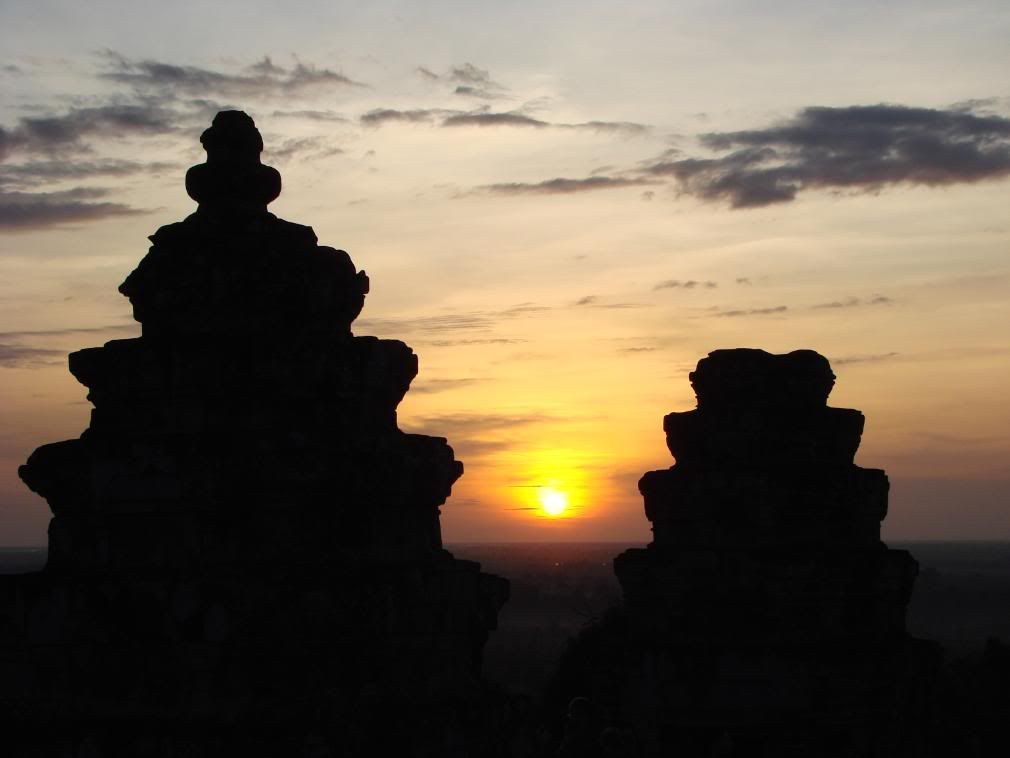 Although we had enjoyed our time in SE Asia, we were ready to move on and are very excited to be heading to our most anticipated destination, the subcontinent of India. (In actuality we have already left India but have had trouble finding high-speed internet to upload our pictures but India updates will be forthcoming very soon; yeah yeah we know you've heard that before).
Although we had enjoyed our time in SE Asia, we were ready to move on and are very excited to be heading to our most anticipated destination, the subcontinent of India. (In actuality we have already left India but have had trouble finding high-speed internet to upload our pictures but India updates will be forthcoming very soon; yeah yeah we know you've heard that before).